

Can Catamarans Handle Big Waves?
The catamaran, with its distinct dual-hulled structure, has become a popular choice among sailing enthusiasts. Often seen gliding gracefully across serene waters, they present an image of stability and luxury. But the real test of a vessel’s capabilities lies in how it fares when the ocean shows its untamed side with big, challenging waves. This article dives into the nitty-gritty of catamarans and their ability to confront the might of the ocean.
Understanding Catamaran Design
The dual-hull advantage.
Before addressing the core question of handling big waves, it’s crucial to understand the catamaran’s design. The two parallel hulls offer a wider base, which translates into greater lateral stability on the water.
Innovation in Naval Architecture
Catamaran design has evolved over the years, incorporating advances in naval architecture. This has resulted in designs that not only enhance stability but also improve wave-handling capabilities.
The Science Behind Catamarans and Waves
Displacement and buoyancy.
One of the key factors in a catamaran’s ability to handle big waves is the concept of displacement and buoyancy. Catamarans are generally designed to have a low displacement, which allows them to ‘ride’ the waves more effectively.
Hull Shape and Dynamics
The hull shape of a catamaran is another critical element. With narrower hulls and a fine entry into the water, catamarans can cut through waves, reducing the impact of big swells.
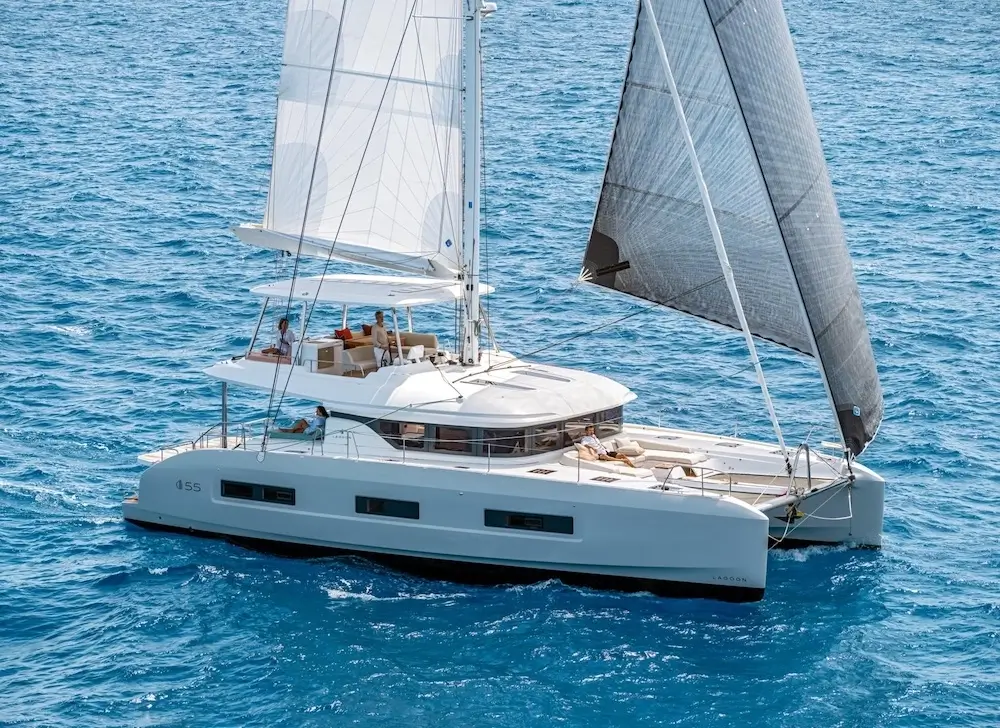
Can Catamarans Handle Big Waves 2
Catamarans in Action: Confronting Swells
The power of the beam.
A catamaran’s wide beam plays a pivotal role in its performance in rough seas. This width provides additional resistance against rolling, which is induced by wave action.
Handling Techniques
Experienced skippers have developed specific handling techniques to navigate big waves in a catamaran. These include adjusting the angle of approach and speed to minimize discomfort and maintain control.
Historical Perspectives on Catamarans and Rough Seas
Accounts from the high seas.
Historical accounts and modern-day experiences from sailors illustrate how catamarans have handled challenging sea conditions. Many of these stories highlight the vessels’ surprising resilience.
Comparative Incidences
When comparing incident reports, catamarans have a track record that suggests they can handle adverse conditions, though not without caution and skill from the crew.
The Role of Modern Technology in Catamaran Safety
Advances in material science.
Modern catamarans benefit from advances in materials that enhance their structural integrity and ability to withstand the force of waves.
Navigation and Weather Forecasting
Technological tools for navigation and weather forecasting have significantly improved the safety of sailing in rough conditions. Skippers can now plan and adjust their journey with real-time data.
Catamarans vs. Monohulls: A Safety Debate
The stability-seaworthiness paradigm.
In the debate between catamarans and monohulls, stability and seaworthiness are often weighed against each other. Each design offers distinct advantages that can be harnessed for safe sailing.
Structural Comparisons
Structurally, catamarans have certain features that can make them preferable in big waves, such as reduced heeling and the absence of a keel to catch the water.
Preparing a Catamaran for Big Waves
Essential safety checks.
Preparation is key to ensuring a catamaran can take on big waves. This includes thorough safety checks and ensuring all equipment is in optimal condition.
Crew Readiness
The readiness of the crew, both physically and mentally, is just as important. Training, experience, and a clear understanding of the vessel’s handling are crucial.
The Role of the Skipper in Wave Management
Decision-making at sea.
The skipper’s decisions can mean the difference between a safe passage and a perilous situation. Knowing when to tackle a wave head-on or when to seek shelter is a critical skill.
Mastery of Maneuvers
Mastering catamaran-specific maneuvers that mitigate the risks associated with big waves is part of a skipper’s expertise.
Catamarans in Various Sea Conditions
Performance in different seas.
A catamaran’s performance can vary significantly depending on the sea state. Calm conditions versus turbulent seas can result in vastly different handling experiences.
The Catamaran Charter Experience
For those considering a yacht charter Croatia , understanding how these vessels handle big waves is particularly relevant. Charter companies often provide skippers who are well-versed in local conditions and catamaran handling.
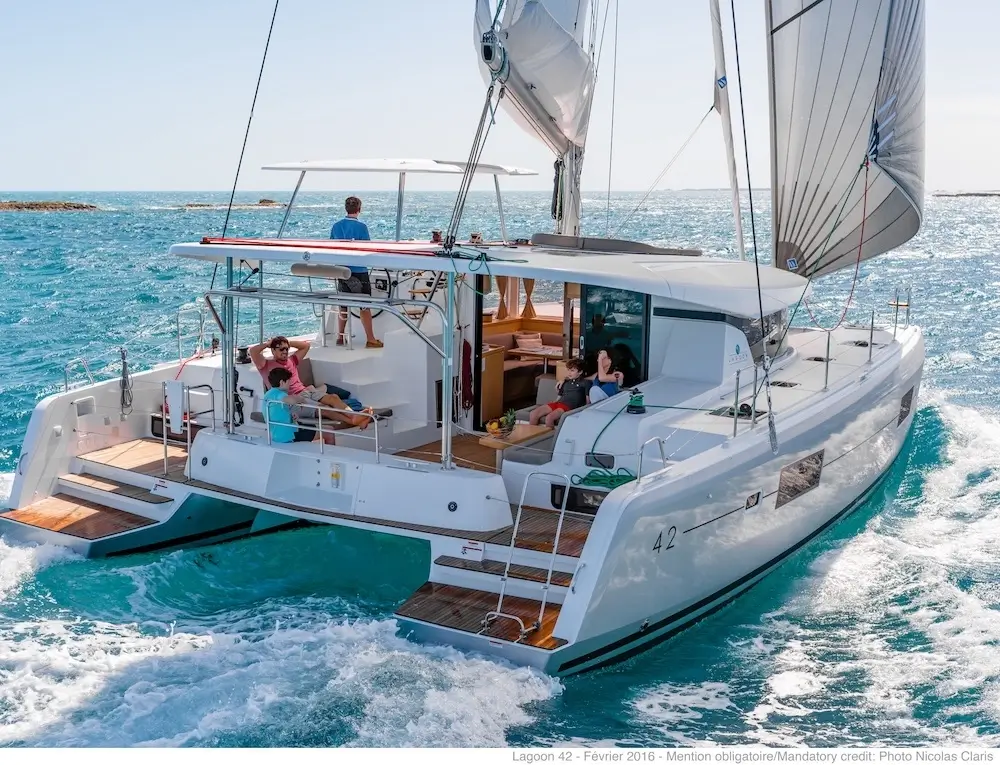
Can Catamarans Handle Big Waves 3
The Future of Catamarans and Ocean Safety
Design trends.
Future catamaran designs are likely to continue to prioritize safety and wave-handling. The feedback loop between user experience and design innovation is ongoing.
Sustainability and Safety
As sustainability becomes increasingly important, eco-friendly materials and designs may also enhance the safety and resilience.
Enhancing Catamaran Safety Through Design and Technology
Advanced hull designs.
Emerging trends in hull design aim to improve the wave-piercing capabilities of catamarans, which is crucial for tackling large waves. These designs help reduce slamming and provide a smoother ride.
Breakthroughs in Stabilization
Active and passive stabilization systems are being integrated into catamarans to maintain comfort and safety in rough waters. These systems can automatically adjust to wave action, keeping the vessel level and stable.
Training and Preparedness: Keys to Handling Big Waves
Importance of skipper training.
Comprehensive skipper training programs, which include handling catamarans in rough seas, are vital. A skilled skipper can utilize the catamaran’s strengths to navigate through big waves.
Safety Drills and Procedures
Regular safety drills and a clear understanding of emergency procedures among the crew can increase the chances of safe voyaging in harsh conditions.
The Psychological Aspect of Sailing in Rough Seas
The confidence factor.
Confidence in the vessel’s abilities and one’s own skills can greatly affect performance in rough seas. A positive mindset and trust in the catamaran’s capabilities are essential.
Managing Fear and Stress
It’s natural to experience fear and stress when facing big waves. Effective crew leadership and maintaining calm are critical for safety and decision-making.
Personal Experiences: Sailors’ Tales of Big Waves and Catamarans
Testimonials of resilience.
Sailors’ stories often feature catamarans withstanding formidable waves, highlighting the resilience of these vessels when properly managed.
Lessons Learned
Incidents where catamarans have faced rough seas provide valuable lessons for manufacturers, skippers, and the sailing community, driving improvements in safety practices.
Selecting the Right Catamaran for Wave Conditions
Assessing the vessel’s capabilities.
When selecting a catamaran, it’s important to assess its design with respect to the specific wave conditions it will encounter. This involves understanding the vessel’s limitations and strengths.
Consultation with Experts
Potential charterers and buyers should consult with naval architects or experienced sailors to understand which catamaran models are best suited for their intended use, especially when considering voyages in areas known for big waves.
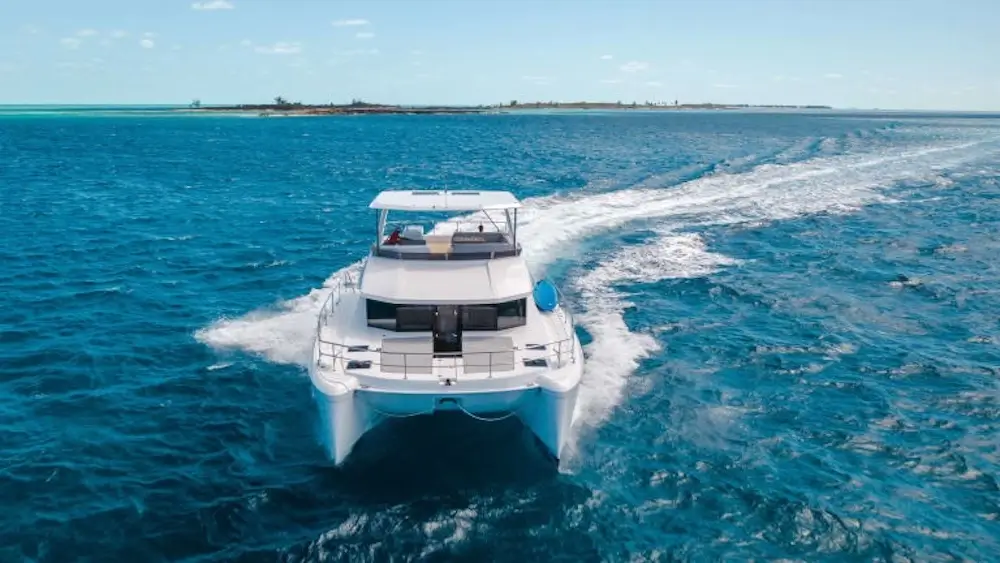
Can Catamarans Handle Big Waves 4
Preparing Your Catamaran for a Safe Journey
Essential gear and upgrades.
Outfitting a catamaran with essential safety gear and considering upgrades that enhance seaworthiness can make a significant difference in handling big waves.
Maintenance and Inspections
Regular maintenance and thorough inspections are critical, especially for the hull, rigging, and safety equipment. Ensuring that everything is in top condition can prevent mishaps in rough seas.
A Glimpse into Catamaran Charters and Big Wave Sailing
Choosing the right charter company.
When planning a catamaran charters , choose a company that prioritizes safety and provides experienced skippers, especially if you’re likely to encounter big waves.
Understanding Charter Itineraries
Familiarize yourself with the charter itinerary and consult with the charter company about alternative routes in case of rough sea forecasts. Being flexible with your sailing plans can increase safety.
Balancing Adventure and Safety on the High Seas
The thrill of sailing.
Sailing a catamaran in big waves can be an exhilarating experience, offering a blend of adventure and the thrill of mastering the elements.
Ensuring a Safe Return
However, the primary goal should always be to ensure the safety of all on board. This balance is what makes a successful and memorable sailing experience.
Conclusion: The Seaworthiness of Catamarans
Catamarans: built for the challenge.
The evidence points to catamarans being well-equipped to handle big waves, thanks to their design, technological advancements, and the expertise of those who navigate them.
Continuous Learning and Adaptation
The key to their successful handling of rough seas lies in continuous learning, adaptation, and respect for the power of nature.
Concluding Insights on Catamaran Safety in Big Waves
Navigating the vastness of the ocean, especially when faced with formidable waves, can be as much about the sailor’s expertise as it is about the vessel’s design and capabilities. As we’ve seen, catamarans bring unique characteristics that can be advantageous in rough seas, provided they are maneuvered with skill and knowledge.
Comprehensive Safety: Beyond Design
Safety is multifaceted.
While catamarans are designed with safety in mind, true seaworthiness comes from a combination of good design, proper equipment, thorough training, and experienced handling.
Importance of a Well-Equipped Catamaran
Ensuring that a catamaran is well-equipped with the latest navigation and safety equipment can turn a potentially dangerous situation into a manageable one.
Building on Experience and Knowledge
Learning from every voyage.
Each journey contributes to a sailor’s experience, and every challenging condition faced at sea is an opportunity to learn and grow in the art of sailing.
Sharing Knowledge for Safer Seas
The sailing community continues to benefit from shared experiences, where lessons learned at sea contribute to the collective safety and knowledge base.
The Role of Weather Forecasting
Staying ahead of the weather.
Modern weather forecasting plays a critical role in sailing. Staying informed about weather conditions can help sailors avoid the worst of the sea’s wrath.
Technology as a Crucial Tool
With advances in technology, sailors can now access real-time weather data, helping to make informed decisions when navigating big waves.
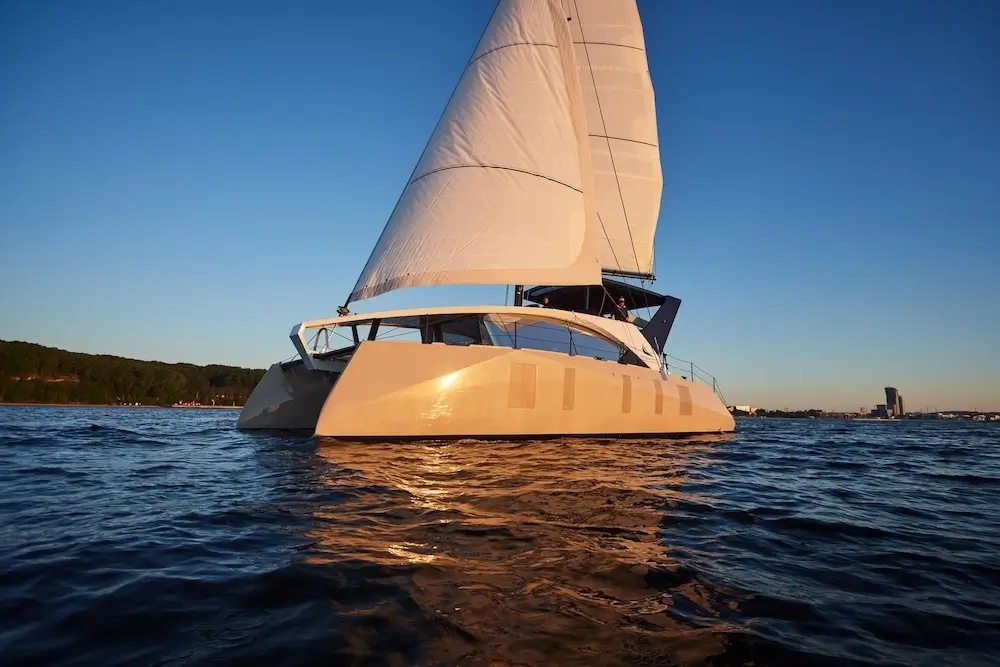
Can Catamarans Handle Big Waves 5
The Human Element: Decision Making in Rough Waters
The skipper’s role.
The skipper’s decisions are crucial, especially in rough sea conditions. A seasoned skipper can read the waves, wind, and weather, making pivotal choices that prioritize safety.
Crew Readiness and Morale
The readiness of the crew and their ability to work as a cohesive unit can greatly affect the outcome of sailing in challenging conditions.
Final Thoughts on Catamarans in Big Waves
A balanced perspective.
It’s clear that catamarans are capable of handling big waves, but they are not invincible. Respect for the sea’s power, coupled with prudent sailing practices, is always necessary.
The Verdict on Safety
With the right conditions, preparation, and handling, catamarans can indeed be safe and enjoyable vessels for facing the challenges posed by big waves.
Conclusion: Embracing the Waves with Confidence and Caution
Catamarans, with their dual-hulled stability and space, offer a distinct sailing experience that can combine safety with pleasure, even in the face of rough seas. While no craft is impervious to the forces of nature, a well-designed and skillfully piloted catamaran stands as a testament to human ingenuity and the spirit of maritime adventure.
Sailors must always weigh the thrill of the journey against the unyielding realities of the sea. The wisdom to navigate safely through big waves comes from a blend of respect for the ocean’s might, confidence in one’s vessel and abilities, and the continual pursuit of knowledge.
Whether you’re charting a course through the crystalline waters of the Adriatic or facing the unpredictable swells of the open ocean, a catamaran can carry you through—provided you carry with you the wisdom of the sea.
Related Posts

Best vegan restaurants on Croatian islands
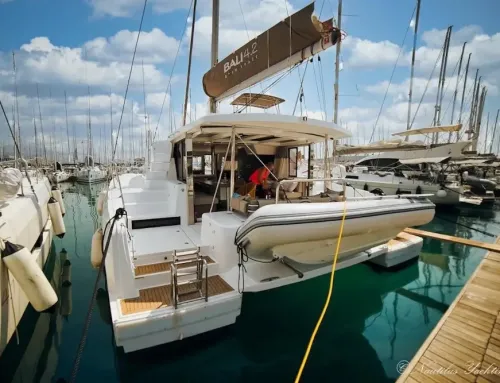
Why Croatia is best for catamaran charter sailing
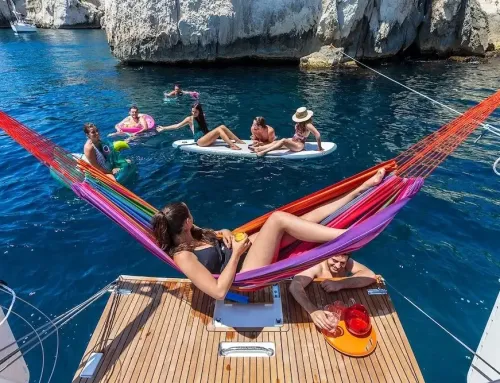
Skippered Yacht Charters: Make unforgettable Sailing holidays
Real Time Availability
Secure Booking Service
No Cost Reservation

EUROPE YACHTS GROUP
Useful sailing links, secure payments handled by.

CONTACT CENTER
HEAD OFFICE Cusmanich LTD Vrboran 37 21000 Split, Croatia
FLEET OFFICE Grabova 21b 21000 Split, Croatia
+385 21 55 33 01 +385 91 3000 009 +385 98 360 398
USA: +1 646 661 2851 United Kingdom: +44 203 318 2329

HEAD OFFICE Cusmanich LTD Vrboran 37 21000 Split, Croatia FLEET OFFICE Grabova 21b 21000 Split, Croatia

about Catamaran Charter Croatia
We are professional charter company specialized in renting catamarans. Our story began in 2004, to address the need for specialized catamaran charter company in Croatia .
get in touch
+385 98 360 398.
Yachting Monthly
- Digital edition

Sailing in waves: top tips to keep you safe at speed
- Toby Heppell
- August 9, 2021
Sailing in waves can be difficult, we find out about the best rough weather tactics to keep you sailing for speed, comfort, safety and enjoyment

Sailing in waves can make for a jarring, juddering experience and long, uncomfortable passages and at worst, a dangerous, boat-rolling hazard. However, it can also mean a thrilling surfing ride to your destination.
Understanding how to set up your boat for sailing in waves, to take advantage of them or ameliorate their worst traits is a skill that it is well worth understanding and practising in order to make your sailing more enjoyable, and to give you the confidence to sail in a wider range of conditions.
Sailing in waves downwind
‘Fairly obviously, the bigger the boat you sail the less of a problem waves generally are,’ say Merfyn Owen of Owen Clark Yacht Design, himself a double Cape Horner and former BT Global Challenge skipper with over 250,000 miles under his belt.
‘To take that to an extreme, if you think about an oil tanker in the middle of an ocean, a wave that would barely wet the deck for her would be something big enough to roll a cruising yacht.
‘It’s really all about the wave energy transfer and the object that the energy is being transferred through, in this case, the boat. So although size is key, when sailing with waves, speed is very much your friend, too, as the energy transfer will be reduced when you are travelling at pace.’
The ‘speed is your friend’ attitude can be difficult to get your head around. Typically it feels counterintuitive when sailing in big waves to want to speed up. Usually in these sort of extreme conditions, slower tends to feel safer but it is something we should all be trying to do in a following sea, to reduce the chance of broaching or being rolled.
‘If you take a fairly modern boat, they all tend to be easier to sail downwind in big waves for a couple of reasons, but one of the key reasons is that they are able to achieve higher sustained speeds downwind,’ says Neil Mackley of North Sails.

‘These days double digits downwind are not uncommon and even high teens are fairly regularly seen. You don’t have to go back too many years before 8 knots was the maximum many boats would be likely to see.’
The faster you sail downwind in waves, though, the more technique is required to reach your destination safely.
There are several factors at play here. Firstly, sailing at higher speeds when surfing down a wave gives your rudder movement greater impact in terms of direction change. Thus when surfing down a big wave, the boat accelerates and it is easy to oversteer and end up with big changes in direction, which also cause big changes in wind angle – a light touch is what is needed with small steering inputs.
The second factor is around choosing your angle down a wave to ensure you are heading in the right direction when you reach the troughs.
It’s not called surfing a wave for nothing, and it helps to think about how actual surfers make their way down a wave, never straight down the face, always at a perpendicular angle to the wave direction.

Photo: OnEdition
Just as the stern begins to lift, accelerate the boat by luffing to a reach. The bigger and faster the wave, the earlier and more extreme an angle change is required to get your boat speed close to that of the wave.
Once surfing, don’t steer straight down the wave: you’ll hit the one in front. If you stop, the wave will roll past and, significantly, your apparent wind angle will suddenly change.
Instead, turn so the boat slides along the face of the wave, upwind or downwind of the wave perpendicular; this extends the time surfing but also keeps the boat at a constant speed.
‘When the wave hits, something has to happen to that energy, which is a function of the wave’s weight and speed. The energy is transferred into the vessel and if the vessel is going relatively slowly and is relatively small then there is sufficient energy in the wave to roll the boat over,’ says Owen.
‘If a 36-footer that weighs 6-7 tonnes and is travelling downwind at 6-7 knots is hit by a wave that is travelling at 30 knots, it is going to be far more impacted than a 6-7 tonne trimaran going at 25 knots.

Understanding the motion of water in waves is key to understanding how best to sail through or with them
‘When the 30-knot wave hits, its relative velocity is 5 knots compared to 24 knots for the boat going at 6 knots. So all that energy and mass hits the boat and the result is that a certain percentage of that energy is transferred into the boat, which subsequently creates the roll. So the faster you can be going at the moment the wave hits, the better.’
Most of us do not sail in a multihull capable of making 20 knots downwind, but the point remains that the faster you can travel the better in terms of energy transfer.
Similarly, if the waves are not big enough to induce surfing or your boat is quite heavy and does not surf regularly down the face of the wave, the technique remains broadly the same.
The main difference when not surfing down waves are that the waves will be overtaking you so you are less likely to come to a stop sailing into the back of the next wave.
Nevertheless, the wave will still accelerate your boat and it is wise to head up just before the wave picks you up to increase speed and reduce the difference between the relative speeds of both wave and boat.
Rolling when sailing in waves
Steering down waves as above assumes the wave and wind direction are matched, allowing you to luff onto a broad reach on either gybe to ensure you are not sailing straight down the wave face.
There are, of course many situations in which you will encounter waves that are not in the same direction as the wind, so on one gybe it will be okay and on another it will be harder.
‘To some extent it is wise to think about taking the favoured gybe until the tide turns and the seastate reduces,’ says Owen. ‘There might be other factors, too; you may be able to get closer to the shore on the favoured gybe. Essentially, you should try to limit the time on the unfavoured gybe where possible and maximise time on the easier – and faster – gybe.’
Of course there are times when sailing in waves that they are going to roll the boat around and this is unavoidable, and it’s all but impossible to pick the perfect angle.
‘I think the biggest issue that a lot of people fear is the old death roll,’ comments Mackley. ‘That is a particular issue on older boats with a relatively wide beam but a narrow transom – they really tend to rock and roll all over the place.’

Rolling in waves is a big fear for many. Tightening the leech on your mainsail with your kicker will help, so will tightening the leech on your spinnaker with a tweaker line
The rolling Mackley mentions is born of a number of factors. In the simplest terms, a wider aft section provides more power downwind and enables the boat to sail faster. However, the effect can also be the result of the underwater shape of the boat reducing form stability.
Article continues below…


How to navigate using waves
Developing a thorough understanding of what the waves are telling you can provide you with a 'sixth sense' when it…

Storm sailing: ‘The boat was slammed over and water poured in’
Randall Reeves leaves the storm jib in its bag while braving the Southern Ocean to prove that speed is safety…
Ultimately it varies from hull shape to hull shape but as a rule, the wider-sterned modern cruisers tend to roll less.
‘There are things you can do to limit that roll, though, and at least provide a slightly less stressful experience. Broadly speaking you will want to sail with less twist in your sails, which helps reduce the rolling motion.
‘Essentially what is happening is if you have a quite open leech, the air escapes off the very top portion of the mainsail. So if you have a lot of twist in the mainsail then the sail at the top ends up being something like 90 ̊ off the centerline. Whereas the bottom of the main with the boom out will be much less than 90 ̊ to the centreline and so be holding power down low. It is the difference in the angle between those that induces rolling in the boat.
‘The top of the sail will spill wind, which allows the masthead to roll to windward and then the keel takes over and rolls you back upright and the whole thing just gets worse and worse. So applying leech tension via the kicking strap will give a more even leech profile and allow the wind to stay attached through the whole length of the leech.
‘With a spinnaker up, the same thing is true, but with the added difficulty that you have a soft leech and luff. The aim is to try and stop the spinnaker rotating round the front of the boat.’
Mackley says that this can be done in a number of ways. Firstly having a ‘tweaker’ line on the sheet is useful. Typically this is a block or ring that allows the sheet to run freely through it, which then runs down to another block on the toerail and to a cleat.

This acts to pull down on the spinnaker sheet but lets the sheet run through it and controls the amount of twist that develops in the leech of the spinnaker.
The result of pulling this on is to stop the leeward side of the spinnaker from rotating round the forestay. ‘There is also a tendency for some people to allow the spinnaker pole to be too far forward, which also allows the top of the spinnaker to float to windward, which also induces the roll,’ Mackley adds.
Sailing in waves downwind in light weather
Although not as intimidating as windier weather, sailing downwind with a following swell can be just as hard.
As a general rule, the difficulty in very light weather is that the swell in effect kills wind. As you accelerate down a big swell, quite often you will see the apparent wind switch from being behind you to in front of you as you overtake the wind.
Speed differences in this situation are fairly small. If there is a 5-knot true wind speed and you are sailing at 3 knots, a significant swell will easily accelerate the boat to 5 knots, at which point you are essentially sailing in 0 knots of wind.
Even though it is not necessary to sail down the face of the wave at an angle to prevent sailing into the next wave in lighter winds, as the waves will typically be moving faster than you are, it is still worth considering sailing more of a reaching angle to increase boat speed and so reduce the difference between apparent wind when sailing down the face of the wave and the true wind speed when not.
In lighter weather you are likely to experience the problem of the mainsail unloading as the boat accelerates down a wave. Using a preventer on the boom can easily solve this, but it is not uncommon to see a boat accelerating down the face of a wave, overtaking the wind at which point the mainsail backs and acts as a large air brake.
This is not going to do any great damage but it is going to slow you down quite a lot and it is better to either let the mainsail flop around a bit or find a faster angle, even if it is a longer route to your destination as you will likely get there quicker.
Sailing in waves upwind
Sailing into a heavy seaway, or even a moderate chop can significantly reduce your speed, pointing ability and comfort. As such, simply sailing into a seaway can make your journey less comfortable and much longer – a double whammy of discomfort.
But if your course to steer is upwind and into a seaway, what can we do without resorting to the engine?
To some extent the answer is condition-dependent, but the basics of wave sailing remain the same. The water in a wave moves in a circular motion: downwind at the top, upwind at the bottom. The essence of sailing over waves is all about ensuring you use the energy locked into the wave to your advantage.

It is for this reason the advice has always been to luff as you climb the face and bear off slightly over the back of the wave. The aim here is to ensure you spend as little time as possible in the peak by luffing, and then bearing away to keep reasonable way on and keep you sailing in a broadly straight line.
Additionally, as you slow down up the wave, the apparent wind moves aft, allowing you to luff further, while as you accelerate down the back of the wave the apparent wind moves forward.
The problem here, though, is the additional steering makes sail trim difficult to master. In flatter water, we can set sails up for the conditions and steer a straight course, safe in the knowledge that barring some significant change in the wind strength or direction the boat will be set up correctly.
‘When it is very windy and you are sailing in big waves it can be very difficult,’ says Mackley. ‘With the sails sheeted on there is not much space to luff and bear away.
‘If you have too much sail area then you get locked into sailing the boat in a very high mode and slowing each time a wave hits, as every time you try to bear away at the top of the wave you are overpowered.’
The trick in these conditions is to give yourself a sail set-up which offers the best power over a wide range of angles. Not only does steering over a wave change your angle to the wind, but the apparent wind will also be moving around a lot too. When you are in the trough and going quite slowly, then the apparent windspeed will be much lower. As you bear off over the peak of the wave, the apparent will be noticeably higher.
‘You should think about reefing earlier than you would normally when sailing in big waves upwind,’ says Owen. ‘When the waves are really big, as well as a difference in apparent wind speed, you will also get a lull in the trough and a gust at the peak, so setting the boat up for the maximum wind strength you are going to experience is important.’ Mackley agrees, explaining that if you normally would reef in 19-20 knots upwind, then in a big seaway you will probably want to put a reef in at 16-17 knots to allow you to drive the boat properly.
‘Sailing with more twisted sails is also key in the windier wavy conditions,’ says Mackley. ‘You might not need to reef, but you will certainly want to sail with a lot more twist in the mainsail and headsail.
‘Essentially what you are trying to do is give yourself a wider groove to sail in, so with a lot more twist in your sails you are able to keep the sail trim right for a higher percentage of the time.’
On a race boat, the trimmers will be focused on the bow and trimming on as it lifts and the boat starts to luff up the face of the wave and then easing the sheets slightly as the helm bears off over the back of the wave.

Plenty of twist in your sails will help with the apparent wind direction changes that occur in big waves, particularly upwind
By putting twist into the sails when cruising we allow for the sails to still be delivering some power through the course of steering without becoming overpowered at the peak and underpowered in the troughs.
‘It is worth remembering that this applies to all your sails. Particularly for boats with a large headsail it is well worth putting twist into the headsail by moving the headsail cars back. It’s often not something people do but it will make a huge difference to keeping the boat evenly powered through the waves and so keeping the boat moving and preventing the situation where she is heeling then sitting upright and then heeling again over and over.’
Sailing in waves upwind in the light
Depending on the speed of the waves, your boat, and its manoeuvrability, there is always a lower limit where it is simply not possible to steer around the waves in the way described above. The waves just shake the boat and rig around; the rig stalls; and the boat bounces up and down, going nowhere.
When the waves are not regular there are always high and low spots. Your focus needs to be on the water half a boat length or so in front of the bow. Steer for the obvious low spots as they appear and avoid the biggest highs: the larger the differences between highs and lows, the further it will be worth deviating from the mean course to minimise the effect of this obstacle course.
If there are no obvious high spots and low spots, sail freer and faster through the worst bits: your speed will at least ensure that the rig and foils are working, whereas trying to sail high and slowly will stall both and contribute to a slide to leeward.
To allow the boat to make good progress through the waves in light winds, we need to generate as much power as possible from the rig.
‘Trying to generate power in light winds and waves, means you are typically sailing with the sheet more eased and a lower mean angle,’ say Mackley. ‘You are not looking for the ultimate in terms of pointing but you are just trying to get the boat powered up and punching through the waves.
‘So you usually ease the sheet a few inches and sail with slightly less tension in the backstay to induce a little more power through headstay sag, which makes a fuller, more powerful sail.
‘You are generally trying to keep your sheeting angle a bit wider and more forgiving. As with windy sailing in waves, you are aiming for a forgiving sail set-up. We are not looking for absolute maximum upwind speed, you are more looking for the maximum forward speed all the time.’
Sailing in waves in extreme conditions
‘Upwind, even in severe waves, it is often okay as long as you can keep enough way on to continue to travel forwards. You will need to foot off quite a bit with very reduced sail but downwind, when a wave gets to a certain size it can be difficult,’ says Owen.
‘I’ve said that speed is your friend and that is certainly the case, but there is a point that you reach where you are going too fast and a broach, or worst a Chinese gybe becomes a very real possibility.
‘I would argue that slowing down is still not the right answer. Given what we know about how likely a wave travelling at speed is to roll a boat travelling at low speed then really you are just choosing the lesser of two evils by sailing quickly, and still reducing your likelihood of being rolled, even if that likelihood is quite high.

The key to sailing upwind in big waves is to make sure you keep enough way on to make progress
‘If you look at fast racing boats these days, they very rarely carry a drogue or similar. It’s not that it wouldn’t work, it’s just that you never have to use it because you have sufficient speed to be okay.
‘So on a boat like that, there is no condition that would ever warrant the need to use one. You are far better off just sailing through it and keeping the boat moving.’
There is always a moment when we need to consider backing out. For those on passage, hopefully you will have identified some ports you can retreat to in your standard passage planning.
If you find that you are struggling to make decent headway upwind in rough conditions, it could well be worth firing up the motor to help drive the boat up a wave face, preventing the keel and rudder from stalling, so you maintain control and avoid punitive leeway. Or perhaps you need to drop the sails altogether.
Usually, if you’re struggling to make decent headway, you can make rapid progress downwind, so identify your nearest safe port (hopefully one that is easy to get into and has sufficient depth) that is downwind of your location and head there.
When to use the motor in waves
When sailing in waves upwind, motorsailing will often help you get to your destination quicker. However, sailing in waves downwind, motorsailing is not usually a useful option as you will, often, be sailing faster than your engine would drive you, so you simply end up wasting fuel in order to have a prop spinning ineffectually under your hull.
With the right skills and attitude sailing in waves can be a great deal of fun, but much of your decision making does need to depend on your crew. If people are prone to seasickness, is there much point in continuing on?
Even if you are really struggling downwind, there is much to be said for taking control of the situation.

‘There have been certain situations I have faced, going downwind in waves, where the boat is rolling around and you are surfing down waves and at a certain point you know it is going to go wrong.
‘For me, I think the best option then is to take control of the situation, give the helm a shove and accept the broach. Sure, you may be knocked down but at least you are prepared for it, and you are being knocked down the right way and it is not a sudden Chinese gybe,’ says Mackley.
Sailing in waves with an autopilot
Autopilots and waves do not always make for the happiest of bedfellows. Things have improved, however, with newer systems able to identify pitch and yaw and adjust steering accordingly.
Even if you don’t have the absolute latest tech, many of us have a system that can steer to wind instead of relying purely on compass heading. This option can be extremely useful in wavy conditions but it is important to ensure you are setting up your autopilot correctly.
‘When sailing downwind, because of potential surging down waves and increased acceleration I almost always set my autopilot to steer to true wind direction,’ says Raymarine’s Greg Wells.
‘Upwind, my autopilot steers a better course than I can. I usually have that set to apparent wind as fluctuations in boatspeed are less dramatic.’
Beyond merely using the autopilot as a labour-saving device, a key use in waves can be to free up hands for sail trim. A key feature in waves is the need to either set your sails up to be forgiving, or trim more as the boat accelerates and decelerates. ‘Last summer, one of our customers was telling us that during the Fastnet they sailed almost the whole time on autopilot sailing two up. This is useful sailing downwind in waves, when it’s easy to become over or under trimmed, which could see you rolling around.’
Enjoyed reading this?
A subscription to Yachting Monthly magazine costs around 40% less than the cover price .
Print and digital editions are available through Magazines Direct – where you can also find the latest deals .
YM is packed with information to help you get the most from your time on the water.
- Take your seamanship to the next level with tips, advice and skills from our experts
- Impartial in-depth reviews of the latest yachts and equipment
- Cruising guides to help you reach those dream destinations
Follow us on Facebook , Twitter and Instagram.
Heavy Weather Tactics
Scores of books have been written about heavy weather sailing, but few of them address the particulars of multihulls and their individual considerations. Monohulls have more commonalities as a group, therefore there are more general guidelines. Storm tactics for multihulls will depend more on the capabilities of crew and vessel than any other factors.
Barreling along at 18 knots in strong winds can be thrilling and is a highlight of multihull sailing. Making no seamanship errors will be as important as the simplest rules of keeping all lines neatly organized and kink free. Often tangled lines have gotten sailors into more trouble than anything else. Keeping a neat cockpit and thinking ahead are the cheapest insurances against mishaps.
In heavy weather the boat should be set up with appropriate safety lines and attaching yourself to them must be mandatory, even if one only ventures briefly into the cockpit. All crew should wear full gear and always have their life jackets at the ready. Each member should have a strobe, knife and whistle permanently attached and there always should be a big knife with a serrated edge mounted in the cockpit to quickly cut a jammed line, if necessary. Basic safety drills, location of life saving equipment, rafts and throw-able MOB devices must be known to each crewmember. Everyone on board must understand the crucial function of EPIRBs, VHFs, firefighting equipment, as well as engine operation and bilge-pump system. It is all really common sense.
If in the highly unlikely event that you capsize, stay with the boat at all costs. Rig one life raft or dinghy to the underside of the bridge deck, fly a kite and wait for help. Never, ever separate from the mother ship as your chances of being spotted will be close to zero in a raft. Staying warm, hydrated, and clear headed will be as important as keeping crew morale up. Salvage as much food and water as you can and secure them, as waves in the interior will wash them out any opening. It has been suggested to await help in the upturned vessel, but unless it is a perfect calm, it will be impossible. Wave surges in the cabins will be violent and there will be leaking battery acid, foul smells and floating objects that will force you onto the upturned platform of the bridge deck.
Storm strategies will depend on the sea state. The shorter and higher the wave faces, the more critical correct seamanship will be. It is my opinion that the use of sea anchors should be carefully weighed and avoided if one can actively deal with the conditions. In theory, they work well if conditions do not change. The crew can rest and the multihull will make nominal drift downwind, provided there is minimal searoom. But the sea is a chaotic environment and waves do not always remain in one and the same pattern, direction, and period. The forces and loads on the boat when tied to a parachute type device can be huge.
True and Apparent Wave Height

Imagine your boat hanging off a sea anchor and suddenly a wave from a different direction slams into the boat from the side. As the boat is not moving, actually drifting slightly backwards, it will not have any possibility to handle this odd rogue wave. The catamaran might be overwhelmed and rotate around its longitudinal axis and flip. Most cruising catamarans that have capsized were constricted by sea anchors. In one well-documented incident, the parachute's lines caught under the rudders and turned the boat.
A sea anchor might lull you into a false sense of security and your vigilance will be reduced. Being caught with your guard down is the most dangerous situation, and I feel it is better to actively deal with storm conditions, rather than letting the boat drift off a sea anchor. Besides, retrieval and deployment are risky, and if not done properly the first time, they can subject crew and boat to more risks.
This is not to say that a parachute anchor does not work. On the contrary, many multihulls have ridden out hurricanes with these devices. Personally, I would want to position the boat to sail with the seas if there is sea room. The vessel's speed should be adjusted to the wave period and therefore would reduce the relative impact of waves. If one's cat sails too fast, even without sails up, a drogue or warps could be dragged behind the boat. Streaming warps off a stern bridle will also be helpful if the boat has lost steerage. It will keep the bows pointing downwind. Ideally, seas should be taken off the rear quarter in order to present the longest diagonal axis to them. This will be the most stable attitude, and a good multihull will be able to handle the most severe conditions. A well-working autopilot, an alert crew, and a strong boat will get you through anything. Concentration will deteriorate as the conditions worsen and any mistake will be very difficult to rectify. Your margin for error will be minimal and advance thinking and anticipation will be key. Approaching a safe harbor during heavy weather can be nerve-wracking and should be carefully weighed with the risk of running aground and encountering much rougher than usual inlets. Often standing off will take discipline but be safer.
Again it should be mentioned that everyone manages differently with storm conditions and there is not necessarily only one right or wrong way to do it. Making the vessel's speed work for you and being able to
Wave heights make great subjects for sea tales, but the altitude of seas are often overestimated. Especially on smaller vessels, when the horizon is hidden, one feels that the seas are steeper than they actually are. The apparent gravitational pull makes one think that the boat is sailing parallel on the horizontal plane. Usually however, the boat is already ascending the next wave, leading to estimation errors as high as 50% in judging wave heights.
Safely slowing the multihull is accomplished by streaming warps or trailing a special drogue. A large bridle is either fastened to the windward hull or to the sterns.
Streaming Warps or a Drogue to Slow Down
Streaming Warps or a Drogue to Slow Down outrun a system will reduce your exposure time. Drifting slowly downwind tied to a sea anchor will expose you to bad weather longer. The advantage of a fast catamaran should be used to get you out of trouble, or even better, by using today's advanced meteorological forecasts, you might be able to avoid it entirely. Yet, once you are in storm conditions, slowing down the boat to retain full control will be challenging.
If there is no sea room, or one is forced to claw upwind, reducing speed to minimize wave impact is imperative to the comfort of the crew and safety of the boat. Finding the right groove between stalling and too much speed is important. You do not want to be caught by a wave slamming into you, bringing you to a halt. This could end up in a lack of steerage and, in the worst case, you could be flipped backwards. Always keep on sailing at a manageable speed and if your boat has daggerboards, both boards should be down one third only. Head closer to the wind towards the top of the wave, and fall off as the boat sails down the slope. This will aid in keeping the sails drawing and boat speed in check. Structural shocks upwind in very strong winds can be very tough, so find the right speed. Reducing your main to 3 or even 4 reefs and furling your headsail for balance will drive you to weather. We all know that this will not be comfortable, but if there is no choice other than to windward, one will manage until conditions have abated. Flatten sails as much as you can to depower the boat. If you need to tack, plan ahead, do it decisively, and with plenty of momentum. You do not want to be caught in irons while drifting backwards. Loads on the rudders with the boat going in reverse can damage the steering, leaving you crippled.
Running off at a controllable speed is the safest way to handle a storm. If you are deep reaching or sailing downwind with the storm, retract both boards if your boat has daggerboards. In the event that the catamaran is skittish and hard to steer, lower one foot of daggerboard on both sides. Long, well balanced, high-aspect-ratio hulls, especially ones equipped with skegs far aft, will track well, even without boards. A tiny amount of jib sheeted hard amidships might be all that is needed to point the boat downwind. Reduce the boat to a speed where you are just a fraction slower than the waves.
Keep in mind that the term "slow" is relative as this could still mean that you are traveling at well over 15 knots!
Sailing with the beam to the storm and seas should be avoided at any cost. If, because of say navigational issues, one has no choice, both daggerboards must be lifted to assure sideways slippage.
Heaving-to is a tactic which lets the boat sail controlled, almost stationary, and should be used only if one has no more alternatives.
This could be caused by crew exhaustion or mechanical issues with the boat. When heaving-to, the helm is locked to windward, a tiny scrap of jib sheeted to weather, and/or a heavily reefed mainsail can be set. The traveler should be let off to leeward and, theoretically, the multihull will steadily work herself to windward. At 40 degrees, she will either be stationary or slightly fore-reach. This does not work on all multihulls and different mainsail and jib combinations should be tested. Also letting the main or jib luff slightly will take speed off the boat, if

far right Boarding via the transom platform, any guest will easily find his/her way to the spacious cockpit by walking down wide, teak-covered steps. Notice the lack of any sail controls or helm station - they are all located out of the way, on the flybridge above.
so desired. Catamarans with daggerboards should only have very little windward board down to avoid tripping.
Similar to "heaving-to" lying-a-hull differs from boat to boat. In this attitude the boat will carry no sails at all and fend for herself. In case of daggerboards, retract them. Most boats will take the seas on their beams (not my favorite) and let the waves pass under them by surfing sideways. Just as trying to avoid the use of sea anchors, this tactic should only be reverted to if one has exhausted every other possibility.
There are a few generalities that will help you learn about heavy weather sailing tactics. Fine-tuning the sails will help depower the boat. As the wind increases, move the mainsail sheeting point to leeward. This is one of the best features of multihull sailing. Multihulls have wide travelers and an extensive sheeting base which allows for more choices for sail trim than narrow boats. Ease off the traveler to move the main to leeward and use a strong outside rail attachment point, such as a cleat or toe rail track to move the jib to leeward. As the wind strengthens, reduce camber and flatten the sails. Double up preventers and reef lines to create backups and divide the loads. In the end, knowing when to reef and how to control your cat is the most important skill to develop to prepare for heavy weather sailing. Practicing maneuvers in strong conditions will raise your level of confidence and prepare you for the worst Mother Nature might have in store for us.
Heaving-to is an important "parking" technique that should be practiced by every catamaran owner. One tacks from a close-hauled position and either luffs the mainsail or furls it completely. Once on the other tack, the jib is left on the "wrong" side and the helm is turned hard to windward. Every multihull will behave differently, and one has to experiment how hard the headsail must be sheeted in or how far the rudders must be turned. Keel catamarans will behave slightly differently than daggerboard cats. The headsail will keep the bows turned away from the seas, while the rudders will prevent the boat from presenting her beams to the waves. In the heave-to attitude, the catamaran will fore-reach and slightly drift to leeward.

Continue reading here: Atlantic
Was this article helpful?
Recommended Programs

Myboatplans 518 Boat Plans

Boat Alert Hull ID History Search

3D Boat Design Software Package
Related Posts
- Motor Sailing - Catamarans Guide
- Catamaran Design Guide - Catamarans Guide
- What is a sea anchor - Heaver Weather Sailing
- Heaving To - Heavy Weather Guide
- Catamaran sailing in rough weather
- More on big waves - Heaver Weather Sailing
Readers' Questions
What size waves can a caramaran handle?
The size of waves that a catamaran can handle depends on various factors, including the design and build quality of the specific catamaran, the experience and skill of the captain and crew, and the conditions of the sea and weather. In general, catamarans are known for their stability and ability to handle moderate to large waves. Some larger, more robust catamarans are designed for offshore sailing and can handle rough open ocean conditions, including large waves of several meters in height. However, smaller or lighter catamarans may be more suitable for calmer or sheltered waters and may have limitations in handling very large waves. It is important to consult the manufacturer's recommendations and consider the specific characteristics of a catamaran before taking it into rough seas. Additionally, it is essential to have proper training and experience to safely handle a catamaran in challenging wave conditions.
Are catamarans good in rough water?
Yes, catamarans are generally considered to be good in rough water. The design of a catamaran with two hulls provides better stability and maneuverability compared to a monohull. The wide beam and low center of gravity of a catamaran make it less prone to capsizing in rough conditions. Additionally, the dual hulls help reduce the wave impact, making catamarans more comfortable in rough seas. However, it's important to note that extreme weather conditions can still pose challenges for any type of boat, including catamarans.
How to sail in a storm?
Secure all loose items in and around the cockpit. Reef main sail if possible. Lower the jib, or furl it tightly if possible. If a storm jib is aboard, hoist it. If single handed, rig a preventer to hold the boom in place if a sudden gust should cause an accidental jibe. Double up all sail sheets, halyards, and control lines. Reduce windage by dropping the mainsail traveler and vang. Keep an eye out for squalls. Wear your life jacket and a wet suit or dry suit if the weather is cold enough. Trim the helm to keep the bow into the waves. Try to maintain a consistent speed and course to avoid broaching. Monitor the boat, keeping it free of water and heeling as little as possible. Be prepared to take evasive action, such as dousing the sails, heaving to, or running off.
Can catamarans handle rough seas?
Yes, catamarans can handle rough seas. They are designed with a shallow draft and wide beam that make them more stable, allowing them to handle the waves better than a traditional monohull boat. Additionally, modern catamarans have been designed to be more resistant to adverse weather conditions, which helps them perform better in rough seas.
Are catamarans safe in heavy weather?
It depends on the type of catamaran, its size and design, but generally catamarans are considered to be very safe in heavy weather. They have a wide beam, low center of gravity and are relatively stable in rough seas. A good quality catamaran will have also good deck drainage and self-draining cockpits, adding to their safety in bad weather.
How well are catamarans in heavy waves?
Catamarans usually have good stability in heavy waves, as their wide, shallow hulls help to provide good lift and reduce rolling. However, the size and weight of a catamaran will determine how well it handles in heavier waves, with larger catamarans generally being more stable in larger waves. It is also important to note that catamarans may not perform as well as monohulls in heavy waves as they often have less grip in the water due to their shallow draft. Therefore, it is important to consider the size and weight of the catamaran when planning to take it out in heavier seas.
How to park a catamaran heavy weather?
Ensure that the sea state is suitable for anchoring and that the area is suitable for your catamaran. Set the anchor and let out chain or rope depending on the type of anchor you are using. Monitor the anchor and the mooring lines for any signs of distress. If possible, secure more anchors or mooring buoys to the sea floor away from the catamaran to increase the overall stability and security. Use fenders to protect your catamaran from the sea swell. Make sure that the crew is off deck and has safety lines in place if they are on deck. Aim to park the catamaran in a sheltered area and away from the prevailing winds. Check regularly to make sure the anchor stays in place and that the mooring lines and fenders remain secure.
Why catamaran rotate beam on wave?
Catamarans rotate their beam on waves in order to remain stable and reduce drag. When a catamaran is moving through the water, its hulls can act like wings, causing the boat to tip sideways. By rotating the beam, the catamaran can counter the sideways motion, allowing it to remain relatively level and cut through the water more effectively. Rotating the beam also helps to reduce drag, helping the catamaran to move faster and more efficiently.
- Lost password
Please Support TheBeachcats.com
- Forums index page
- :: Catamaran Sailing Discussion
- :: General Sailor Talk
- View latest posts
- Search forums
Sailing in big waves
- Print topic
- Registered: Aug 18, 2003
- Last visit: Dec 13, 2023
- Registered: Nov 25, 2015
- Last visit: Mar 21, 2024
- Registered: Jan 17, 2019
- Last visit: Jan 13, 2020
- Rank: Lubber
- Registered: Apr 01, 2016
- Last visit: Apr 12, 2022
- Rank: Master Chief
- Registered: Jun 20, 2006
- Last visit: Jan 19, 2024
- Posts: 7087
- Registered: Oct 24, 2006
- Last visit: Jun 21, 2023
- Registered: Mar 19, 2004
No HTML tags allowed (except inside [code][/code] tags)
- Submit Preview Cancel
Font size: Tiny Small Normal Large Huge
Your browser does not support javascript or you turned it off. The BBCode interface has been disabled.
Your browser does not support javascript or you turned it off. The bbsmile interface has been disabled.
Users on-line
- jack108136 ,
- tamumpower1
This list is based on users active over the last 60 minutes.
Search The Beachcats
[ Add New Beachcat Event ]
Upcoming Beachcats Events
VIEW FULL CALENDAR
- June 6, 2024
- "Live on the Edge" Multihull Regatta and Race Clinic, Eugene, Oregon
Copyright TheBeachcats.com
Yachting World
- Digital Edition

Catamaran sailing: expert multihull techniques
- Nikki Henderson
- February 18, 2022
Moving to a performance multihull can be a leap for even the most experienced cruiser. Nikki Henderson shares expert multihull techniques.

There has been a huge surge in the sales of performance multihulls and with them a need to know how to handle them particularly when it comes to specific multihull techniques. The market for these boats is broadening; multihull cruisers are upgrading, monohull sailors are upsizing, and even virgin boat owners are tempted.
Over the last 12 months, while coaching for Outremer , I’ve met hundreds of these owners, everyone from young families to retired couples moving aboard a new catamaran and setting sail on a circumnavigation. Handling a performance catamaran is achievable even for a novice multihull sailor. But there is a big difference between just ‘getting by’ on such a boat versus sailing efficiently, safely and in style.
The transition for even experienced sailors can be quite a step up. For a seasoned monohull sailor, the differences are obvious: increased volume and speed, and a lack of heel. Even for an existing multihull sailor, the handling and performance is noticeably less forgiving and requires a shift in focus and technique.
This winter, I set sail on a transatlantic with the new owners of an Outremer 55 . They have previously owned another less performance-orientated catamaran but invited me on board to coach them to fine tune the boat, assist with routing, and help them take best advantage of all the performance their new yacht offers. Here are a few of the topics we focussed on:

sailing at higher speeds will change everything from manoeuvre techniques to weather routing. Photo: Robin Christol/Outremer
Most non-planing monohulls will do approximately the same speed on all points of sail. However, a performance multihull might sail at twice, three, even four times its upwind speed on a reach.
For example, the factory polars of an Outremer 55 give its average speed in 20 knots of wind with a true wind angle (TWA) of 50° at 8.5 knots, but in the same windspeed with a TWA of 110° it’s 19.1 knots. That’s more than twice as fast. How do you make the most of this speed advantage? And how do you best manage it ?
In a monohull it often pays to slog it out for days sailing the best course to windward as this normally gives the best velocity made good (VMG). A dead downwind rhumbline route is the usual strategy for longer ocean passages, rather than sailing more miles and wider angles.However, on a performance multihull it is important to prioritise reaching when route planning.

aboard high performance catamarans, such as this TS42, you can race competitively in offshore events. Photo: Jacques Vapillon/Sea&Co
In upwind conditions on a long crossing, consider whether bearing off by even as much as 20° will result in a better VMG, even if it feels counterintuitive. In light winds bearing off to 70° or 80° TWA can be the difference between a totally stalled boat and 5 knots of boat speed .
Faster speeds open up the possibility of keeping up with pressure systems as they move around the globe. For example, if crossing the North Atlantic eastwards, ideally you’d leave the US in clear weather with a depression forecast to leave the American coast a few days later.
You could use its predicted track to decide how much north or south to add to your easterly heading, to ensure that as it catches up with you, you are sufficiently south enough of it to pick up its strong westerlies. As they approach, you will accelerate, and if you can hold the speed you can use that downwind airflow to push you most of the way across the pond.
Handling at speed
Controlling and handling the boat at these higher speeds requires a change in strategy. Increased speeds and acceleration mean that the apparent wind angle and apparent wind speed change much more frequently. So you need adaptable and flexible trimming and driving solutions.

Use twist to balance power and control. Photo: Robin Christol/Outremer
Downwind the boat should be carving S-curves through the water to ensure it achieves the best VMG possible. If you can get this right you will attain the momentous double figure average speeds that a performance multihull offers, while also going the right direction! Instead of allowing the speed to plummet at the end of each surf, as the bow sinks into the bottom of the wave, a performance multihull can just keep on going.
How to maintain speed:
1 Sail at higher angles to build up apparent wind speed (AWS) and boat speed.
2 Soak downwind as the apparent wind angle (AWA) surges forward with the acceleration.
3 Drive the boat back slowly upwind in time to maintain the average speed and continue the surf.
In an ideal world, to achieve this the boat would be hand-steered. But realistically, no cruisers want to be on deck for two weeks straight on a transatlantic crossing. Your best compromise is to invest in a top quality, well set up autopilot, as well as good wind instruments.
Set the autopilot to sail to apparent wind angle and watch how the boat slaloms through the ocean. The quality of the autopilot will really start to show its value when the sea state starts to increase. The best ones improve over time as they collect data and learn the wave patterns. If you aren’t sure exactly which AWA is ideal, choose a day that has very consistent wind and sail in open water. Set the autopilot AWA to 90° and then systematically increase the setting by increments of 5° at fixed time intervals until you get as low as you can before the foresail is shadowed behind the main. Measure the VMG by comparing the distance travelled at each of the different wind angles, and the average A to B course over ground (COG) achieved. This will give you a good starting point, and then it will shift further depending on sea states and wind strengths.
Sail setting
Another solution if you want fast speeds but don’t want to actively sail the boat to within an inch of its life is to use twist. Twist is a compromise between having a hardened sail that stalls when the wind goes aft, or a very eased sail that luffs when it goes forward. The more changeable the conditions, the more extreme the acceleration increases are, or the rougher the sea state is, the more twist you need.

Cats have the space and stability to hoist and douse, so keep weight low by dropping flying sails when not in use. Photo: Christophe Launay
The wide beam of a multihull allows for a long traveller, so most won’t have a vang. Sheet tension and traveller position are your primary controls to create twist in the mainsail. Begin by finding a full power setting in the main.
Set your autopilot to 35-40°AWA; most performance multis should make this upwind. Set your traveller at midships and over-ease your mainsheet so that the sail is luffing. Gradually tighten your mainsheet until the top telltale just flies. Manual winching offers better control here than electric.
Pull your traveller to windward until the boom runs down the centreline. The top telltale of the mainsail will now be flying about three-quarters of the time. If it is closer to 50% you may need to tighten the mainsheet further and then ease the traveller until you have achieved this (or vice versa). This is your full power sail shape, and your default car position upwind.
At this point some people like to mark the mainsheet (this doesn’t work with a continuous mainsheet). To begin with, just take note of the traveller position. If the conditions require more twist, ease the mainsheet, and pull the traveller to windward to keep the boom in the same position relative to the boat. You could keep a note of three traveller positions for each point of sail: full power, mid power, low power.
As the wind moves aft, you can add other ‘go-to’ traveller positions for different wind angles by easing the traveller down to leeward while keeping the mainsail shape set to ‘full-power’ mode. Once the wind goes aft of the beam, your traveller will be all the way down to leeward. Keep an eye on spreader chafe at this point.
Once you are happy with mainsail trim, you can trim the jib in a similar way, using car position and the sheet tension. Bring sheet tension in so that the leech shape looks very similar to the main: flat with a slight curve at the top. Then adjust the cars (if you can) so that the sail is not luffing, and the top telltales are also flying 50-75% of the time. Finally, walk forward to the forestay and view the slot between the sails. Do they look roughly parallel? If not, you may need to open up the slot a touch by moving the car outboard. This is your default jib car position for that point of sail.

Sailing the angles with an asymmetric. Photo: Kinetic Catamarans
When conditions increase, don’t forget to add twist to the jib too. Initially just ease a touch of sheet. Be careful moving the car too far inboard or you might close the slot. Moving the sheet attachment closer to the foot of the clew will open up the leech and create more twist.
Think of twist as the middle ground between sailing fully powered and reefing. Multihulls are much less communicative than monohulls. You do not have the obvious signs that the boat is overpowered, like a submersed toe rail or rounding up as the boat heels.
In time you’ll get to know your catamaran and build a connection to read how aggressively the boat is accelerating, its fore-aft pitching, sounds, and rhythm. But at first it’s useful to have some number guides and wind parameters of when to add twist and ultimately when to reef.
Generally a performance cat will require a reef much earlier because it’s lighter. I’d usually put in one reef at 20-25 knots, two at 25-30 and three reefs for 30-35 knots.
On our transatlantic crossing on the Outremer 55, contrary to my advice on the advantages of sailing angles downwind, we chose instead to sail dead downwind with the symmetric spinnaker up for the entire passage.

taking it easy dead downwind under symmetric Photo: Nikki Henderson
There are costs to taking full advantage of the speed of a performance catamaran. Averaging 15 knots boat speed is not everyone’s idea of comfortable. The hulls are so stiff that every wave that hits the hull sounds like the beating of a drum. The humming of carbon rigging, the swooshing of water screaming past the topsides, the slapping of the waves, the wind: it’s incredibly loud even when averaging 10 knots, let alone 15 or 20.
Performance multihulls are also so lightweight that they are really thrown about in a substantial sea state. Our decision to sail dead downwind rather than heating up and taking full advantage of the performance came down to the following reasons:
1. Lack of adequate autopilot We had one, but it wasn’t able to react quickly enough to the acceleration and resulting rapid change of wind angle that broad reaching would have created. It also struggled in a big seaway, so sailing with the waves square on to the stern was easier to cope with.
2. Sails We did not have a heavyweight asymmetric sail, which is what you need to sail these downwind angles (both our reaching sails were light weight).
3. Safety Akaroa II is hull No2 of a new design by Outremer. This was the first transatlantic crossing that this particular model of boat had ever done, so we were a testing ground and deliberately cautious.
Despite our conservative approach we still achieved 90% of the factory polars averaging 9.6 knots in sustained winds of 20 knots across the entire 2,700-mile route.
The trip took 11 days and 17 hours. The beauty of a performance multihull is that even if you don’t push it, you still manage brilliant speeds in the right conditions.
We calculated how much faster we would have gone, had we sailed the angles instead of running downwind. This assumes we would achieve the same 90% polars. TWA 140° appears to be the sweet spot.

Getting the main down when reefing can be problematic – rig up downhaul lines to help grind it down if needed. Photo: Nikki Henderson
Without any power being dispelled by heeling, performance multihulls will convert additional power into acceleration. With this increased speed comes increased loads on the lines, blocks, rudders, sail cloth and rigging. Winches are upsized. Jammers are used instead of clutches. Halyards are 2:1. You may be sailing on a 50-footer, but the loads are akin to a 70-80ft bluewater monohull.
A future owner recently reminded me of this, when he opened the main traveller jammer while holding the line with only one wrap on the winch. The lack of skin on his hand was gruesome evidence of how surprising the loads can be when a multihull is really powered up.
Interestingly, comparing a standard cruising multihull with a similar sized performance multihull, the opposite is true. A boat that weighs less needs less sail area to power it. For example, a Lagoon 450 has a sail area (main and jib) of 130m2 compared to an Outremer 45 (actually 48ft LOA) at 104m2. So, for the same apparent wind speed, there will be less load on the gear.
Watch out when sailing downwind. Due to a performance multihull’s ability to accelerate and hold high speeds downwind, it is easy to hold significantly more sail area in higher true wind speeds as the apparent stays low. However, if you do hit the bottom of a wave and stop dead in the water, the sail, rigging and lines will feel the full force of that wind.
Another reason to reef earlier than you think on a performance multi is that with swept back shrouds (needed to support the mast without a backstay) and a fully battened mainsail, even with the halyard eased downwind the sail may still not come down. You should be sailing with the minimum amount of sail cloth up to achieve the polars.
Reducing sail
1. Rig up downhaul lines from each reefing point on the luff to help grind down the sail. Keep an eye on chafe on the leeward side on each of the batten pockets.
2. Use the rotating mast to open the sail to the wind more.
3. If that isn’t enough, come upwind to help get the sail down.
Multihull trim
Switching to a performance catamaran may bring new trimming options: daggerboards, a rotating mast, and fully battened square topped mainsail.
Brush up on your fundamentals of sail trim so that you have a solid foundation to build on. When you first start sailing the boat, to avoid getting overwhelmed (which tends to result in people under-sailing their boat), begin by finding a base setting for all points of sail. Forget the rotating rig for now, but find enough twist in the sails that gives you enough height without too much power. Set the daggerboards as you would on a dinghy: down for upwind, up for downwind, mid-way for a reach. Then you fine tune.

Set performance cat daggerboards as you would for a dinghy at first: down for upwind, up for downwind, mid-way for a reach. Photo: Nikki Henderson
When adjusting daggerboards, make sure you have your GPS track switched on. See if dropping a little more daggerboard helps with the COG upwind. Downwind, if you feel like you are on an ice-skating rink, try dropping a little board for better grip. If on autopilot, take note of the rudder angle. If it’s taking the helm from full starboard to full port then it might need some more grip, if not then a reef.
Be cautious of the risk of ‘tripping up’ in big seaways. In sea states much over 3-4m, it’s safest to lift the daggerboards and allow the boat to glide over the waves rather than risk one of the boards digging into a wave and destabilising the boat. While exceptionally unlikely to happen, if a daggerboard digs in, the worst case scenario would be a capsize. If you see any slick in the water that suggests the boat is sliding sideways over a wave, or an increase in heel, or significant water over the deck – these are signs that it’s time to lift the boards all the way up.
Finally, play with the rotating mast. At a basic level, try to get the mast in line with the foremost sail position and curve. The easiest way to see this is actually to stand forward of the mast and look down the line of the sail. It is in itself a foil and when in the right position can add the equivalent of as much as 10% more sail area. In the same way, you can use it to depower by reducing the angle.

With a rotating mast you’ll generally be trying to get it in line with the foremost sail position and curve. Photo: Nikki Henderson
When fine tuning sail trim I’d recommend marking all your tracks and angles of mast rotation, and once you are confident you could mark the sheets and halyards themselves. This is an exercise for the detail-orientated and it pays to be specific. Keep a notebook at the helm station to record your learnings, and over time build up not just ideal trim settings for wind and waves, but also polars.

The inside story of Greta Thunberg’s upwind Atlantic crossing on La Vagabonde
The sky flashed a blinding white light and a spark came down just a few hundred metres to port. We…
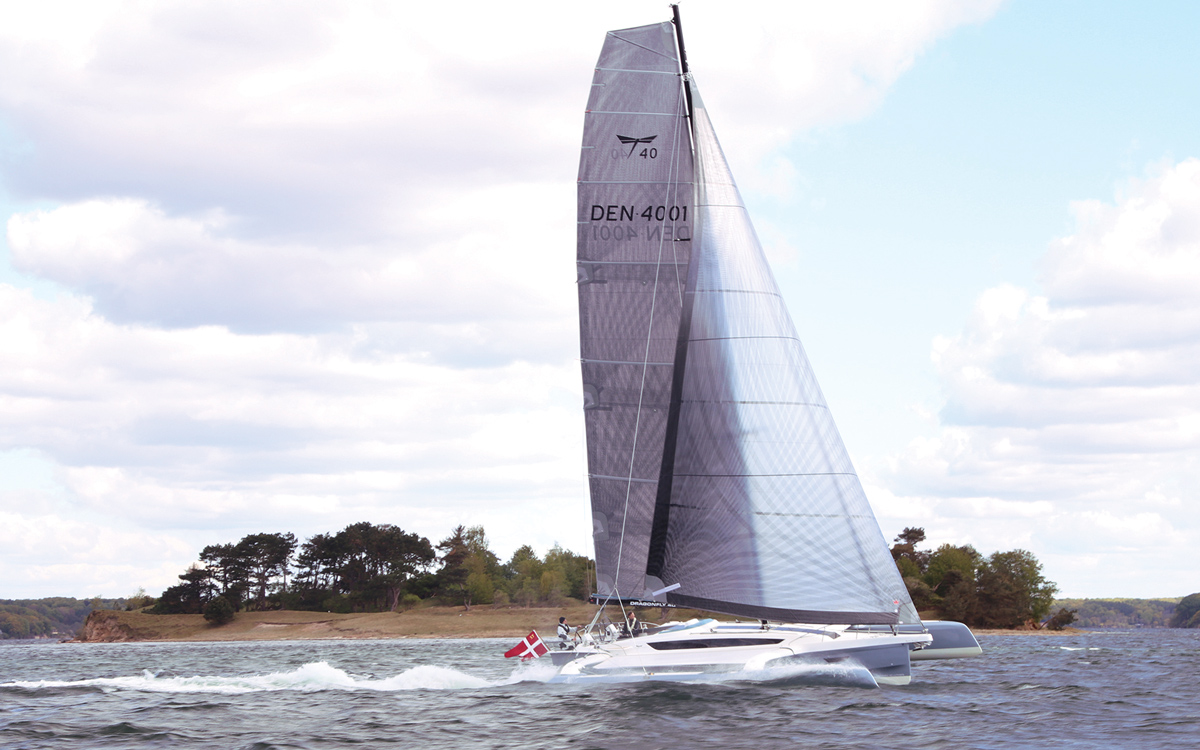
Mainsail handling: Advanced sailing techniques for catamarans and multihulls
A mainsail cannot know whether it is hoisted on a monohull, a catamaran or a trimaran. The principles of sail…

The best bluewater multihulls of all time: a complete guide
What are the best bluewater multihulls for long term cruising? The one you own, or the one you can afford…
Learning a performance catamaran’s sensitivity to weight can be a real learning curve. Compared to cruising catamarans, performance cats tend to be half the weight (or even less). Meanwhile, compared to a monohull the main difference is in the areas where the weight is most concentrated. A monohull’s weight is predominantly in its keel. Almost the entire weight of the boat is concentrated in around 15% of the boat’s length. Conversely, a multihull has no keel, so without that pendulum effect its centre of gravity is higher and less stable. On a multihull the weight is distributed along almost 90% of its length.
In practice, this means that what you carry, both below and above decks, has a big impact on the boat’s performance and safety. The first step is to become minimalists. Summon your inner Marie Kondo and ask yourself “Does this bring me joy? Does this keep me safe?” of every single item that moves from dock to boat. If it doesn’t – don’t take it.

Performance cats are weight sensitive so streamline your possessions onboard. Photo: Carl Newton
Step two is to arrange your belongings evenly around the boat. Ensure you don’t list the boat to port or starboard. Try to keep weight amidships and ideally low down. Avoid loading up the bow lazarettes or aft areas with too much weight.
When sailing, don’t forget that the worst kind place for weight is aloft. Without the keel, you significantly reduce the stability of the boat by having a furled Code 0 (for example) hanging around up the rig. It’s inconvenient to drop it every time, but it’s worth it.
Higher speeds, bigger loads, a lighter boat and higher centre of gravity don’t sound like the safest characteristics, and they aren’t if poorly managed. But you can also use them to your advantage. Being able to sail faster means you sometimes have an option to run away from bad weather.
But there are other safety drills that are worth thinking about ahead of time. What is your MOB recovery plan? With cats’ high freeboard, some owners plan to reverse up to the casualty and pick them up from the steps at the back. But how many have practiced that? Will it involve dropping the mainsail? Could the props injure the casualty? How does the back of the boat behave in a significant sea state? I’d recommend practising this until you have a plan that works for you on your boat with the equipment you have. The same should be said for plans to evacuate the boat, or deal with a fire on board.
If you enjoyed this….
Yachting World is the world’s leading magazine for bluewater cruisers and offshore sailors. Every month we have inspirational adventures and practical features to help you realise your sailing dreams. Build your knowledge with a subscription delivered to your door. See our latest offers and save at least 30% off the cover price.

Catamarans In Rough Seas? Facts and Figures From Sailors!

As an Amazon Associate, we earn from qualifying purchases. We may also earn commissions if you purchase products from other retailers after clicking on a link from our site.
I had my first “real” sailing experience 11 years ago on a monohull in the Bahamas, before that I worked at a Ferrari workshop. Coming from a “dry-land-racing” world made me wonder why some would argue that cats are unsafe in rough seas. They should be more stable since they have a wider base, just as in the racing world, right? A few years later I still hear this old statement that catamarans arent safe for rough weather, so today ill try to add some info on the topic.
Catamarans are safe in rough seas because their double-hull design and wide stance make them highly stable. They’re also easy to maneuver, have shallow drafts, and high speeds that help them outrun storms. Still, you need a skilled crew capable of controlling the vessel to ensure your safety.
In this article, we’ll explore several reasons why catamarans are safe in rough seas. We will also take a deeper look at what makes catamarans capable of handling rough sea conditions. Keep it here to discover valuable tips on how to sail your catamaran safely despite the weather.
Table of Contents
Catamarans Are Practically Unsinkable
A capsized monohull might right itself up, but guess what? A well-designed cruising catamaran is very hard to capsize and almost impossible to sink. This doesn’t mean that it’s okay to go looking for storms to conquer, though. So, what makes a catamaran so difficult to sink, even in the unlikely event that it flips over? Let’s find out.
If you want to dive a little deeper into Catamaran capsize statistics I suggest my other article: Why catamarans capsize!
Catamarans Are Highly Stable
In rough seas, a catamaran will show its superior performance through its twin hulls. Rough seas are defined as waves that rise to heights between 2 to 6 feet (0.6 -1.8 meters).
The hulls turn a catamaran into a floating platform that’s pretty sturdy. In addition, their wide stance and solid construction make the vessel extremely stable, allowing it to withstand the water’s constant pounding motion. The larger the boat, the more stable it gets.
The result is a smooth ride with minimal to no rocking from wave action. As a result, you are less likely to suffer from motion sickness on board a catamaran. A stable platform means reefing and sail changes become much easier and safer, particularly during rough weather. You suffer less fatigue and are thus more alert. Furthermore, there is minimal risk of anyone suffering severe injuries or falling overboard.
Cats Are Easy To Maneuver
Catamarans manufacturers employ various design and structural techniques to enhance maneuverability. Firstly, the bridgedeck positioning is above the water to create a high bridgedeck clearance , which contributes to a ride that is free from loud noises called bridgedeck slamming. Something that old school cats had problems with and would prematurely fatigue the crew.
Read this article to understand what makes a great blue water catamaran (a cat that’s design for rough seas)!
Secondly, catamarans are lightweight vessels, making it easier to steer and control them. Therefore, if you get caught up in rough weather, you are more likely to be able to handle the waves correctly and safely.
In addition to the double hulls, cats also have dual engines , making it easier to maneuver the vessel in and out of tight spots. This feature is particularly useful when you need to escape an oncoming storm and find shelter in a crowded marina. What’s more, if one engine fails as you try to outrun a storm, you can always rely on the second engine to get you to safety.
As mentioned earlier, an alert crew is essential for vessel safety in all weather conditions. And since catamarans are easy to maneuver, crew fatigue becomes a lesser issue, allowing you to sail from rough seas to safety.
It’s also easy to learn how to sail a catamaran , even as a new sailor. As a result, you will be more comfortable with your boat, promoting more straightforward navigation in rough waters.
How long does it take to learn to sail a catamaran? Check this out!
And if you want to get started right away I suggest signing up for two free lessons with NauticEd
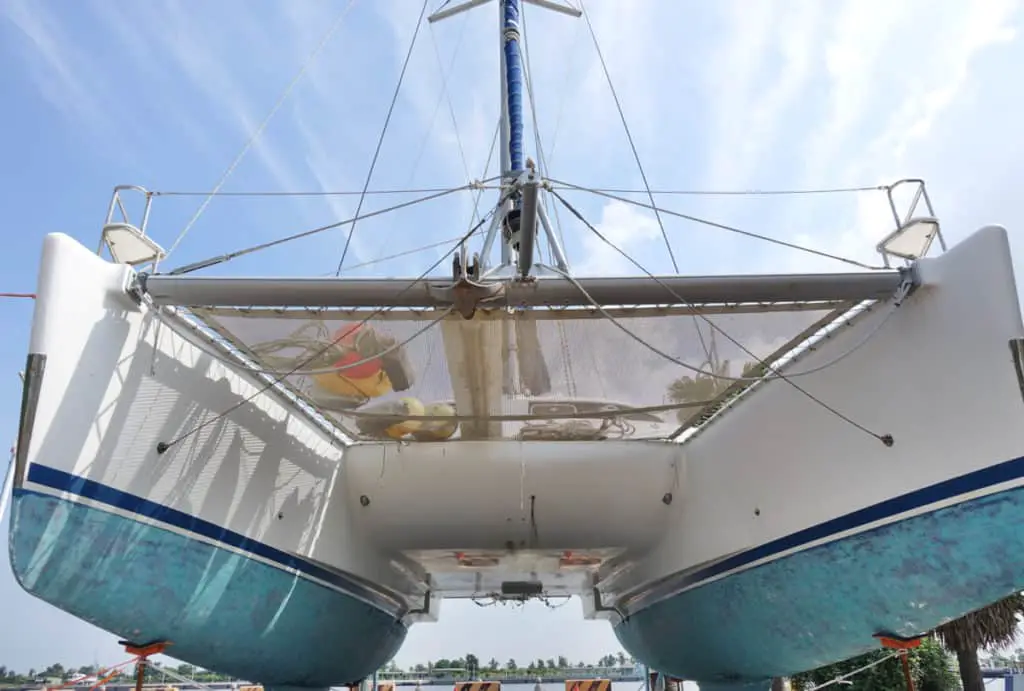
Catamarans Have Less Draft
Because catamarans rely on the buoyancy from their twin narrow hulls (instead of one wide hull on a monohull), they can handle a shallow draft without hampering either their stability or maneuverability. Cats also spread their weight equally between the twin hulls, which allows them to sit much higher on the water.
A shallow draft means a catamaran has more shelter options when bad weather is imminent . You can also anchor your boat much closer to the shore where it’s relatively safe.
You can actually park your cat on the beach, something that is referred to as “ beaching “.
They Are Incredibly Spacious
You might be wondering how ample space has anything to do with safety in rough seas. Let me explain. Catamaran layouts are well-thought-out, with spacious rooms being a major consideration. As a result, most areas, including the cockpit, main saloon, accommodation quarters, and galley, are exceptionally cozy. This enhances sailing comfort and also allows for 360-degree saloon views, which greatly improves visibility for the helmsman.
Another benefit is that there’s ample storage space, and all the sailing gear and equipment have a home. So, your gear is well-organized and stowed away carefully without crowding every available space. In rough seas, it helps the crew and anyone else on board avoid potential injuries from flying gear.
A large storage capacity also means larger fuel supplies. This is important, especially during rough weather as the engines work harder to motor through the strong currents hence they require more fuel.
Catamarans Do Not Heel
As mentioned earlier, ocean waves don’t affect catamarans as much as monohulls because, unlike monohulls, these boats don’t heel or roll (or at least not as much). This is why it’s easy to take a stroll either on the catamaran deck while under sail. The lack of heeling also makes it easier to handle the boat.
Still, due to the wide bridge deck fastened between two hulls, heavier seas could generate slapping or pounding sounds while underway (see bridgedeck clearance).
Check this article out to understand bridgedeck clearance!
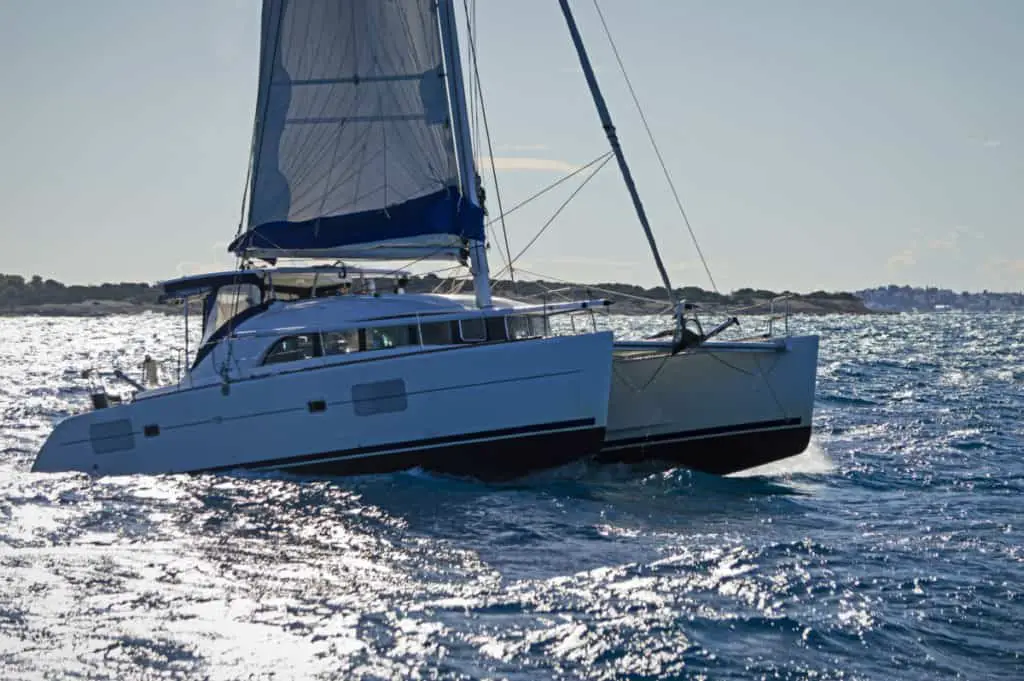
Catamarans Have High Speeds
The best way to keep your vessel safe is to avoid bad weather . But this is not always possible as you could still get caught up in a storm – despite the availability of weather reports. Fortunately, because catamarans are light, they deliver impressive speeds that you can count on at such times.
Fast speeds mean you can escape rough seas by outrunning storms and bad weather.
Cruising cats attain an average speed of 9 knots (10.5mph) while sport cruising cats can reach upwards of 30 knots ( 35mph). Also, performance cruising catamarans boast narrow waterline beams , generous sail plans, and centerboards that make them sail way faster than average cats.
Which Is Safer in a Storm; Catamaran or Monohull?
If comparing similar-sized vessels, a catamaran is much safer in rough seas and storms than a monohull.
This is due to several reasons:
- Catamarans have a larger platform: Because of its large and wide base, a catamaran is more stable and can withstand pounding waves much better than a monohull.
- Catamarans are faster. You are more likely to outrun rough weather in a cat than a monohull since its design enables it to sail much faster. Besides, the higher speed allows you to cover extensive distances in minimal time. This enables you to navigate through heavy sea conditions waters much more quickly or evade them altogether.
- Catamarans are easier to maneuver . Double engines make it easier to maneuver a catamaran in and out of tight spots, such as when getting into a marina or steering across small inland waterways. Monohulls, on the other hand, have only one engine, which could lead to trouble in case of engine failure during a storm.
- Catamarans have less draft. As mentioned earlier, a catamaran will sit much higher on the water than a monohull hence it can sail with ease on shallow waters. During a storm, it has more shelter opportunities and can pull anchor closer to the beach and away from the rough seas.
- Catamarans are not likely to sink. While a capsized monohull would right itself owing to its lead keel, a catamaran wouldn’t. Nonetheless, because of the positive buoyancy, a capsized cat would not sink, which isn’t the case for a monohull. The crew in a capsized catamaran can therefore wait for help onboard the floating vessel.
Are Catamarans Safe for Ocean Crossing?
Catamarans are sea-worthy vessels capable of making long sea passages. Larger catamarans are exceptionally safe for ocean crossing since they have lots of buoyancy and great roll inertia. They can sail through fairly uncomfortable conditions and handle strong winds without taking much of a beating.
Furthermore, the boats are not likely to capsize even when breaking waves hit them as these merely cause them to surf sideways.
Lastly, a cat’s ample storage capacity also means that it can carry enough fuel, water, and food for the passage . Hence, you need not worry about running out of your supplies in the middle of the ocean.
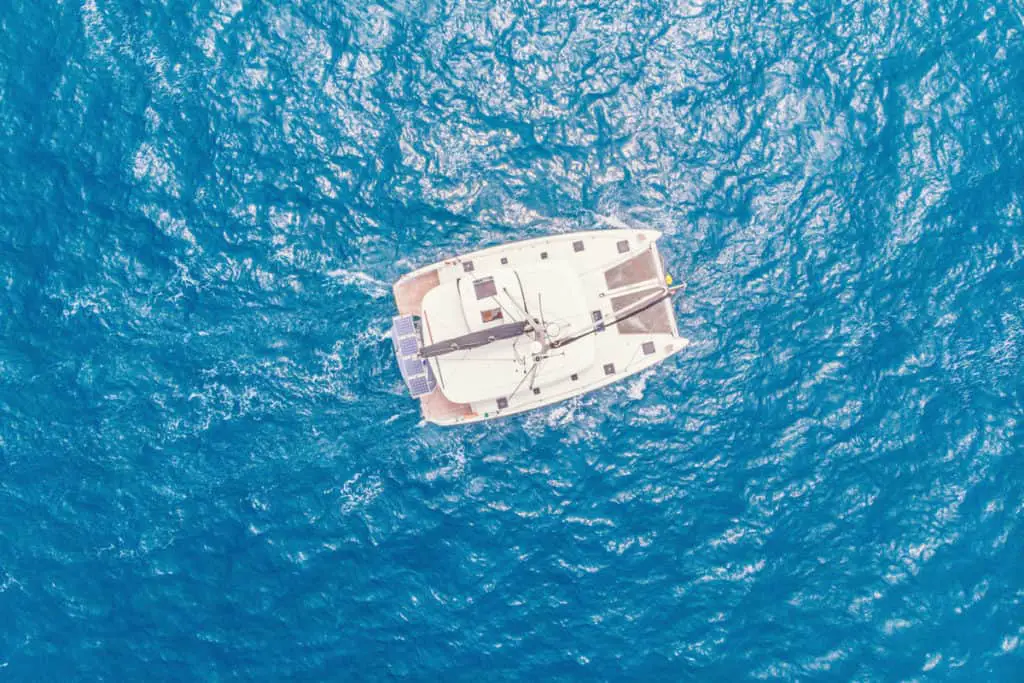
Do All Catamarans Perform the Same Way in Rough Seas?
Depending on catamaran design, performance will vary, a small boat (below 40ft) will be slower and react more to waves, a larger catamaran (+45ft) will move faster and be less impacted by heavy seas and strong winds.
In general, a vessel’s seaworthiness boils down to the construction quality, seamanship level, and boat design.
Nonetheless, high-performance cruising cats can sail windward faster than the best keelboats. Featuring efficient daggerboards, deep rudders, plus less displacement and windage, they deliver a good performance windward in all kinds of weather.
And since these catamarans are light in weight and contain ample sail plans, you need to pay special attention to your sail choice to maintain safety in all weather conditions.
But not all catamarans behave like high-performance cruising catamarans. Therefore, you need to have a deep understanding of how your boat operates before you set off into the open sea. This is only accomplished through spending time on the water.
Tips on How To Sail Safely in Rough Seas
There are fundamental safety measures as well as storm tactics. These are essential when sailing in any weather, but more so if you get caught up in rough seas.
- Undergo training. Get sufficient training on basic sailing and what to do in the event of an incident at sea. Basic safety drills are also important, and all crew should know the specific location of all life-saving equipment.
- Find out details about the expected weather. Make sure you are able to get updates while under sail, either through satellite or mobile network.
- Have the right protective equipment. Always have protective gear on board, including life jackets and vests, close at hand. Set up the boat with the appropriate safety lines and attach yourself to the same. Crew members should carry a knife, strobe, and whistle as well.
- Avoid putting your catamaran on the direct path of breaking waves (beam reach). Instead, opt for a course that places both the wind and high waves either ahead or behind the beam. Minimize the chances of a wave crashing across the deck by tacking in relatively smooth water.
- Park your catamaran. If the storm gets too intense, consider parking ( heaving-to ) your cat. This will give the boat some break from the windward pounding.
The specific storm strategies you need to use will crucially depend on the condition of the sea.
I would recommend you read the book Multihull seamanship ( amazon link ), the graphics are lame but the book is very informational, it walks you through procedures such as heave-to and what to do in case of emergency.
For additional tips on how to maintain the safety of your catamaran in rough seas, watch the video below:
Frequently Asked Questions
Should i run my catamaran straight downwind or angle it away from the waves.
It’s better to run downwind but at a slight angle since this will help increase the effective catamaran length by offering its diagonal distance to the following seas. The slight angle allows the bows to bury less, keeps the hull stable, reduces the risk of pitchpoling, and also makes it much easier to follow the sea.
How Much Sail Should I Use in Rough Seas?
When facing rough conditions it’s best to go with a minimal sail area (such as a storm jib). Minimal sail helps to calm the vessel, which makes autopiloting relatively easier. This means that you might not need to handle the helm, leaving the autopilot to do its work.
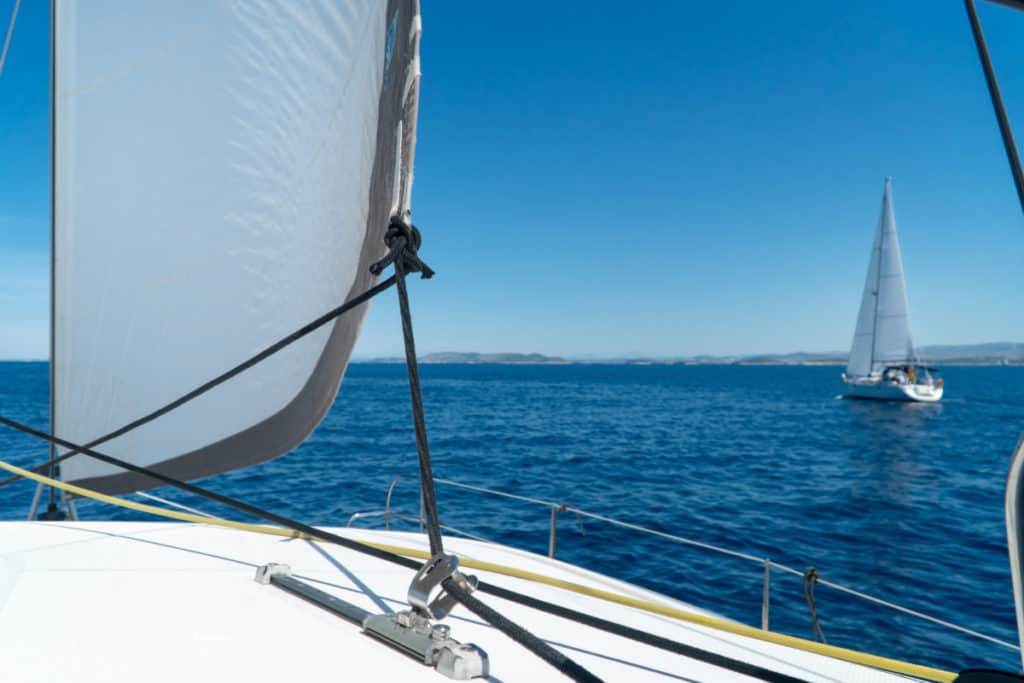
Does a Catamaran’s Length Affect Its Ability To Survive Rough Seas?
Yes, it does. A catamaran with a long waterline handles high winds and towering waves better than a small cat. The easier motion facilitates crew maneuvers, while the high boat weight increases resistance to tossing and rolling caused by the wind and waves. In addition, the higher speed helps in running from the storm.
What´s the perfect size cat for ocean sailing?
What Can Cause a Catamaran to Capsize?
A huge wave to the catamaran’s beam or surfing down a wave and burying the bows in the next wave, making it frontflip or pitchpole. To better understand catamaran capsize I suggest you read my scientific approach to understanding capsizing here .
Final Thoughts
Sailing in rough seas is a true test of seamanship. I used to be afraid of the seas, now it has become my friend. Maybe it will be the same for you! Take care!
Owner of CatamaranFreedom.com. A minimalist that has lived in a caravan in Sweden, 35ft Monohull in the Bahamas, and right now in his self-built Van. He just started the next adventure, to circumnavigate the world on a Catamaran!
Leave a Reply Cancel reply
Your email address will not be published. Required fields are marked *
Save my name and email in this browser for the next time I comment.
Recent Posts
Must-Have Boat Gear for Catamaran Sailors!
Sailing is probably the most gear-intensive activity I've ever done; there are so many decisions to be made about what gear to buy now, for tomorrow, and what to definitely never buy. The gear on...
6 Best Trailerable Trimarans For Bluewater and Coastal Sailing
Having a boat costs a lot of money, even when you are not using it, marina fees, etc. And once it is in the water most sailors never go very far from their "home marina" and sailing will be somewhat...
- AI Generator
927 Catamaran Waves Stock Photos & High-Res Pictures
Browse 927 catamaran waves photos and images available, or start a new search to explore more photos and images..
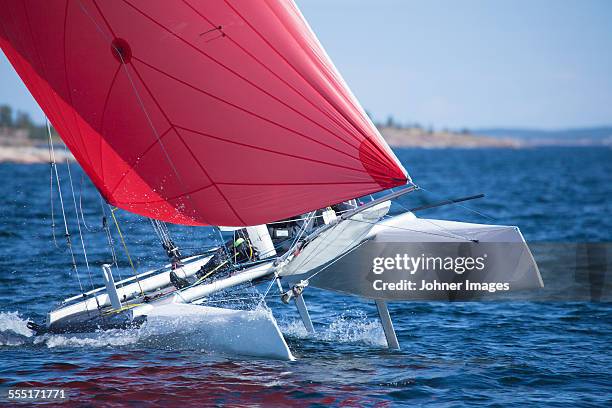
Na Pali Catamaran
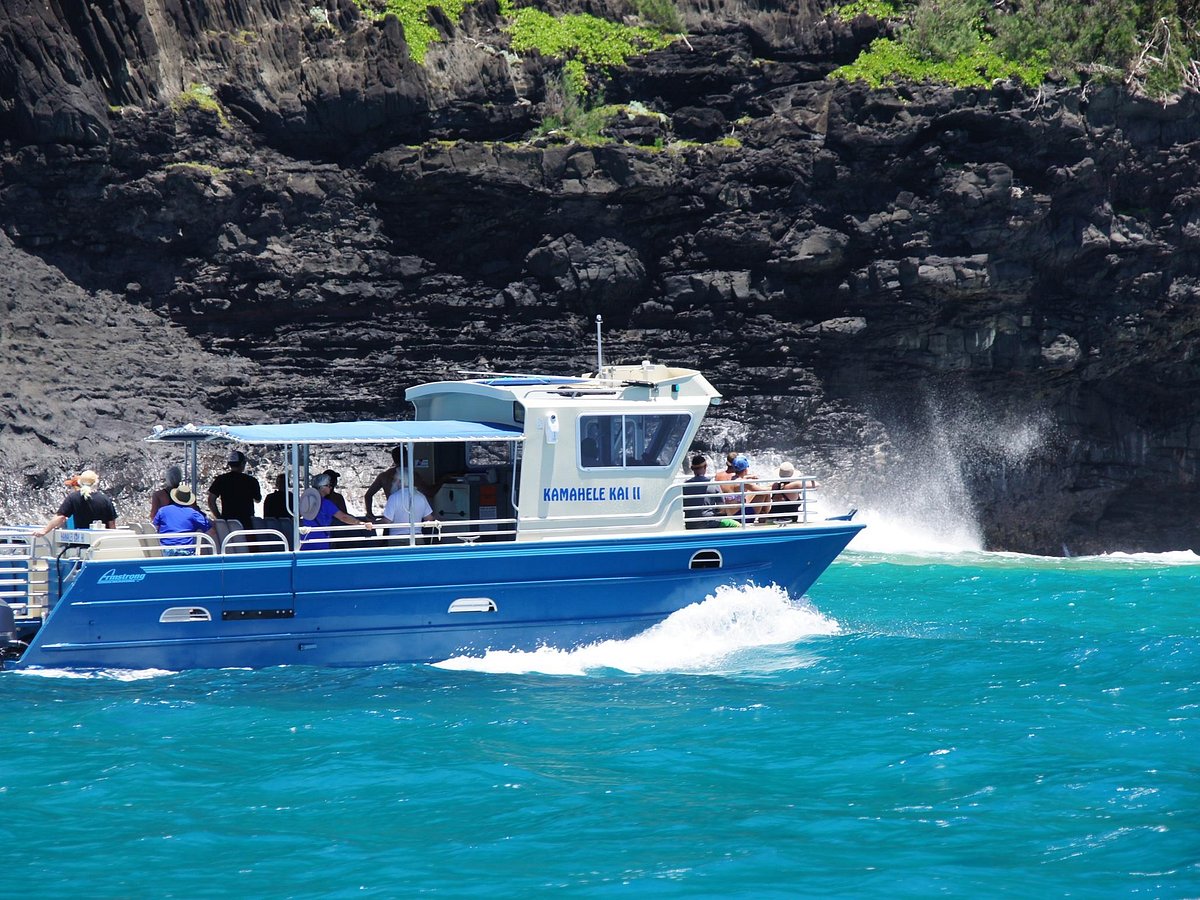
- See all photos

Similar Experiences

Most Recent: Reviews ordered by most recent publish date in descending order.
Detailed Reviews: Reviews ordered by recency and descriptiveness of user-identified themes such as wait time, length of visit, general tips, and location information.
Na Pali Catamaran - All You Need to Know BEFORE You Go (2024)

Why there's no big wave of immigrants voting illegally
Former President Trump often claims that big waves of immigrants who aren't U.S. citizens are voting in our elections — and influencing outcomes — with Democrats' blessing. They're not.
Why it matters: There's no evidence such voting has ever happened on any significant scale. But the conspiracy theories live on, fueled by Trump, Elon Musk and others who keep injecting hard-to-imagine scenarios into the debate over border security.
- "They are allowing these people to come in ... they are signing them up to vote," Trump told a crowd at a campaign stop in Iowa in January.
- "That's why you are having millions of people pour into our country, and it could very well affect the next election."
Reality check: Non-citizen immigrants are barred by law from voting in federal elections. The very few who try it typically do so by accident, and are caught. The penalties can be severe, and include prison time or deportation .
- Voting as a non-U.S. citizen "is a federal crime ... a removable offense, meaning that you can be deported," Sean Morales-Doyle, director of the Brennan Center Voting Rights Program, told Axios.
- "The stakes are really, really high. And it's really easy to figure out that you did it," Morales-Doyle said.
Undocumented immigrants in particular are widely known to steer clear of giving out personal information or registering for anything involving U.S. and state governments, out fear of facing arrest or deportation.
- Some have even avoided public services they're entitled to, such as food stamps or housing benefits.
Between the lines: It's theoretically possible for a foreigner to first lie about their citizenship status to register to vote, and then commit a federal crime by voting.
- Voters typically are required to provide some kind of proof of identity to register to vote, such as a driver's license.
- Not all of those ID methods require citizenship, but voter registration and voting records are both recorded, making it easy to catch non-citizens at various points in the voting process.
- States are required to regularly vet and update voter rolls, to look for anyone who isn't eligible.
- Many states have passed additional measures aimed at ensuring voters are U.S. citizens.
When non-citizens have ended up on voter rolls it's often by accident — not part of any conspiracy to affect an election, Morales-Doyle said.
- There have been several cases in which DMV officials have mistakenly led non-citizens to register to vote under "motor voter" policies.
Zoom in: Republicans seeking to justify claims of illegal voting by immigrants point to a few reports and probes that purported to have found large numbers of non-citizens who registered to vote or voted. Those claims wilted under scrutiny.
- In 2019, Texas began investigating what GOP officials claimed were as many as 100,000 non-citizens on the state's voter rolls.
- The alleged number of illegal registrants ticked down as the claims were examined. The investigation fizzled, and eventually a federal judge killed the probe, saying it was infringing on eligible voters' rights.
- On the heels of Trump's first campaign for president in 2016, the Brennan Center for Justice examined about 23.5 million votes in 42 jurisdictions, looking for evidence of the illegal voting by non-citizens that Trump had claimed was prevalent.
- It found about 30 suspected illegal votes.
Even so, Trump's claims about illegal voting have undermined confidence in elections, mainly among Republicans.
- In 2016 he claimed — without evidence — that he lost the popular vote to Hillary Clinton by 2.8 million votes because 3 million undocumented immigrants had voted.
- In 2020, he blamed his close losses to Joe Biden in several key states on thousands of illegal votes. His team lost dozens of court cases trying to prove it.
- Now Trump controls the Republican National Committee — whose new leaders are asking prospective hires whether they believe Biden was legitimately elected in 2020.
What to watch: Some municipalities have enabled non-citizens to vote in local elections — including in California, Maryland, Vermont and Washington, D.C.
- Those voter rolls are separate from the national voter registration process, and don't allow non-citizens to also vote in state or federal elections, Morales-Doyle said.
Get more political stories in your inbox with Axios Sneak Peek.

Thank you for visiting nature.com. You are using a browser version with limited support for CSS. To obtain the best experience, we recommend you use a more up to date browser (or turn off compatibility mode in Internet Explorer). In the meantime, to ensure continued support, we are displaying the site without styles and JavaScript.
- View all journals
- Explore content
- About the journal
- Publish with us
- Sign up for alerts
- 22 March 2024
‘Best view ever’: observatory will map Big Bang’s afterglow in new detail
- Davide Castelvecchi
You can also search for this author in PubMed Google Scholar
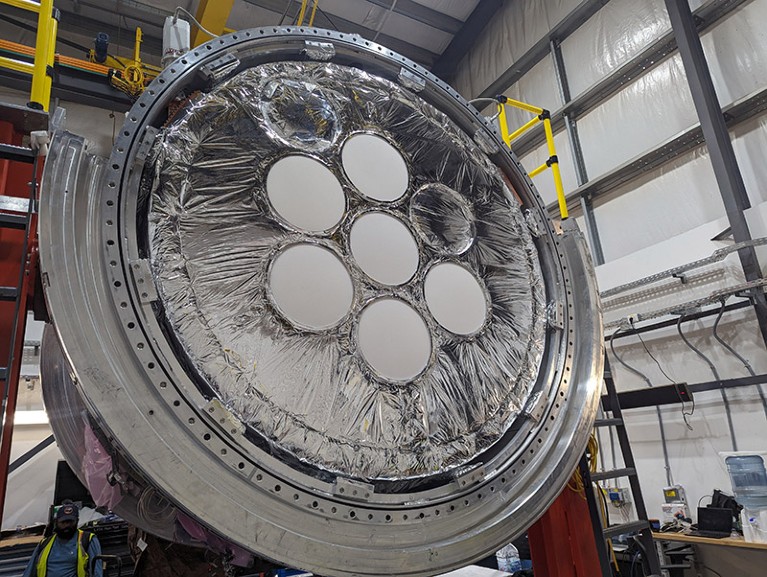
The front of the Simons Observatory’s Large Aperture Telescope Receiver, the largest receiver for observing the cosmic microwave background built so far. Credit: Mark Devlin/University of Pennsylvania
Cosmologists are preparing to cast their sharpest-ever eyes on the early Universe. From an altitude of 5,300 metres on Cerro Toco, in northern Chile’s Atacama Desert, the Simons Observatory will map the cosmic microwave background (CMB) — sometimes called the afterglow of the Big Bang — with a sensitivity up to ten times greater than that of the previous gold standard, Europe’s Planck space probe .
“It will be the best view of the CMB that we’ve ever had,” says Jo Dunkley, a cosmologist at Princeton University in New Jersey and one of the leading researchers in the observatory’s team. Construction of the US$109.5-million observatory is due to be completed in a matter of weeks.

Big Bang telescope finale marks end of an era in cosmology
One of the project’s goals is to find fingerprints left in the CMB by gravitational waves that originated from the Big Bang itself. These would provide the first incontrovertible evidence for cosmic inflation , a brief moment in which expansion is thought to have proceeded at an exponential rate. During that time, quantum fluctuations on a microscopic scale are thought to have seeded the Universe with what became its large-scale structure — including the current distribution of clusters of galaxies across space.
The scientific collaboration is led by five US universities and the Lawrence Berkeley National Laboratory in Berkeley, California. The project is named after Jim Simons, a mathematician, billionaire hedge-fund investor and philanthropist, and his wife Marilyn. The Simons Foundation in New York City contributed grants of around $90 million to build the observatory.
Once construction is complete, engineers will begin the months-long process of fine-tuning and testing the observatory’s instruments before its science programme can fully begin.
Signs of inflation
The Simons Observatory is an array of four telescopes. Three are identical 0.4-metre small aperture telescopes (SATs) and one is the 6-metre Large Aperture Telescope (LAT). Together, they will map minuscule variations in the temperature of the CMB from one patch of the sky to the next, as well as the CMB’s polarization, which is a preferential direction in which the radiation’s electric fields wiggle as the microwaves propagate through space.

China’s mountain observatory begins hunt for origins of cosmic rays
The three SATs will concentrate on a patch covering 20% of the southern sky. The aim is for them to study large-scale swirls — spanning an area several times the apparent size of the Moon in the sky — in the polarization field of the CMB. (Polarization maps look like arrays of sticks, and the orientations of the sticks can form specific swirling patterns called vortices.) It is here that the signals of cosmic inflation, known as B-mode patterns, are expected to show up.
Many cosmologists see inflation as the most plausible mechanism for the process that gave the Universe its structure. Inflation is proposed to have been caused by an energy field called the inflaton, whose nature and properties are mysterious. Many theories have been proposed, predicting gravitational-wave signatures of a wide range of intensities.
It is therefore not guaranteed that the signal, if it exists, is strong enough for the Simons Observatory to see it, says Suzanne Staggs, another Princeton cosmologist who is the observatory’s co-director. “But oh my gosh — if they were right there, it would be amazing.”

The Simons Observatory site photographed from the side of Cerro Toco in the Atacama Desert, Chile. Credit: Mark Devlin/University of Pennsylvania
The known physics of quantum fields suggests that the signatures should be within the Simons Observatory’s sensitivity range, or close to it, says Marc Kamionkowski, a theoretical astrophysicist at Johns Hopkins University in Baltimore, Maryland, who was among the first researchers to predict the existence of B-mode patterns in 1997 1 , 2 .
While the SATs focus on a relatively small area, the LAT will map 40% of the sky, at much finer resolution, and record temperature fluctuations in the CMB, as well as the CMB’s polarization. Cosmologists working on Planck and other past CMB projects have been able to extract troves of information by plotting the intensity of those temperature fluctuations against the area of sky that they span. Such graphs enabled cosmologists to produce precise estimates of both the Universe’s age (13.8 billion years) and its composition (only around 4% of which is ordinary matter).
The LAT data could help researchers to detect signals of cosmic inflation in low-resolution polarization maps made by the smaller telescopes. In particular, they will be crucial for separating that pattern from spurious signals produced by effects such as dust in the Milky Way, explains Mark Devlin, a cosmologist at the University of Pennsylvania in Philadelphia who is co-director of the observatory. The experiment will be six times more sensitive to the polarization patterns than any previous attempts 3 to measure them.
Exploring unknowns
However, searching for signals of inflation is only one of the project’s goals: the Simons team plans to get much more science from the observatory’s high-resolution map of the CMB. It will enable researchers not only to visualize the Universe at an early age, but also to study how its primordial radiation was affected during the 13.8 billion years it spent travelling in space, before it got to Earth.
In particular, the CMB is diverted by the gravity of large clumps of galaxies and dark matter — a phenomenon known as gravitational lensing — and this can be exploited to produce 3D maps of those clusters. Devlin, Staggs and their collaborators pioneered this technique with an earlier high-precision CMB project called the Atacama Cosmology Telescope , which was in operation from 2007 to 2022, also at Cerro Toco, and has yet to publish its final results. The Simons team will reconstruct the gravitational lensing experienced by the CMB, and determine how much of this is due to the Universe’s neutrinos. This will enable them to calculate the mass of these particles, which is still unknown. “It is a guaranteed signal,” says Brian Keating, an astrophysicist at the University of California, San Diego, who is the project’s principal investigator.

Physicists Anna Kofman and Simon Dicker at the University of Pennsylvania in Philadelphia work on the dilution refrigerator inside the Large Aperture Telescope Receiver. Credit: Mark Devlin/University of Pennsylvania
Because the LAT will be scanning the same regions of sky repeatedly over its lifetime, it will also be able to track the motion of asteroids in the Solar System and monitor active black holes at the centres of other galaxies — and how their output changes over time. “We’re going to be able to track 20,000 or more active galactic nuclei, which are, we think, supermassive black holes with jets,” Dunkley says.
Ambitious follow-up
The observatory will have two runs, each lasting about four years, with a planned $53-million upgrade in between. An even more ambitious project called CMB-S4 , to be led by the US Department of Energy and the National Science Foundation, is planned as a follow-up, with observations beginning in the mid-2030s. With telescopes at both Cerro Toco and the South Pole, the $800-million array will improve sensitivity to the inflationary signal by another factor of six.
It is hoped that some of the Simons Observatory’s hardware could be reused as part of the CMB-S4, although the details have not yet been ironed out, says John Carlstrom, an astrophysicist at the University of Chicago in Illinois who is project scientist for the CMB-S4 collaboration.
In 2014, a team working on a CMB experiment at the South Pole called BICEP2 made a bold claim to have detected the inflationary signature, but later retracted it when it became clear that what they were seeing was galactic dust. Since then, direct detection of gravitational waves — coming not from the Big Bang, but from astrophysical phenomena such as pairs of black holes merging — has become routine . Cosmologists are excited to get another chance to spot the primordial signals. “We’re talking about 13.8 billion years ago, with energy densities 15 orders of magnitude larger than anything we can create in the lab,” says Kamionkowski. “It’s kind of remarkable that we can even talk about this.”
doi: https://doi.org/10.1038/d41586-024-00333-z
Seljak, U. & Zaldarriaga, M. Phys. Rev. Lett. 78 , 2054 (1997).
Article Google Scholar
Kamionkowski, M., Kosowsky, A. & Stebbins, A. Phys. Rev. Lett. 78 , 2058 (1997).
Ade, P. A. R. et al. Phys. Rev. Lett. 127 , 151301 (2021).
Article PubMed Google Scholar
Download references
Reprints and permissions
Related Articles

- Astronomy and astrophysics
- Astronomical instrumentation

This super-Earth is the first planet confirmed to have a permanent dark side
News 28 MAR 24

Thermonuclear explosions on neutron stars reveal the speed of their jets
Article 27 MAR 24

The complex circumstellar environment of supernova 2023ixf

Two giant US telescopes threatened by funding cap
News 29 FEB 24

The Dimorphos ejecta plume properties revealed by LICIACube
Article 28 FEB 24

Giant ‘bubble’ in space could be source of powerful cosmic rays
News 26 FEB 24

Do black holes explode? The 50-year-old puzzle that challenges quantum physics
Muse 14 MAR 24

How dwarf galaxies lit up the Universe after the Big Bang
News 28 FEB 24
Tenure-track Assistant Professor in Ecological and Evolutionary Modeling
Tenure-track Assistant Professor in Ecosystem Ecology linked to IceLab’s Center for modeling adaptive mechanisms in living systems under stress
Umeå, Sweden
Umeå University
Faculty Positions in Westlake University
Founded in 2018, Westlake University is a new type of non-profit research-oriented university in Hangzhou, China, supported by public a...
Hangzhou, Zhejiang, China
Westlake University
Postdoctoral Fellowships-Metabolic control of cell growth and senescence
Postdoctoral positions in the team Cell growth control by nutrients at Inst. Necker, Université Paris Cité, Inserm, Paris, France.
Paris, Ile-de-France (FR)
Inserm DR IDF Paris Centre Nord
Zhejiang Provincial Hospital of Chinese Medicine on Open Recruitment of Medical Talents and Postdocs
Director of Clinical Department, Professor, Researcher, Post-doctor
The First Affiliated Hospital of Zhejiang Chinese Medical University
Sir Run Run Shaw Hospital, School of Medicine, Zhejiang University, Warmly Welcomes Talents Abroad
“Qiushi” Distinguished Scholar, Zhejiang University, including Professor and Physician
No. 3, Qingchun East Road, Hangzhou, Zhejiang (CN)
Sir Run Run Shaw Hospital Affiliated with Zhejiang University School of Medicine
Sign up for the Nature Briefing newsletter — what matters in science, free to your inbox daily.
Quick links
- Explore articles by subject
- Guide to authors
- Editorial policies

IMAGES
VIDEO
COMMENTS
Nothing puts a greater load on a catamaran than a breaking wave on the beam. While nearly every catamaran is engineered to CE Class A-1 codes for open water, a 90-degree impact from a wall of water hitting a cat's slab sides and large windows will put your boat at maximum risk. Choose a course that puts the waves and wind ahead or aft of the ...
Our PREFERRED Sailmaker: http://bit.ly/precision_sailsPLEASE SUBSCRIBE: http://bit.ly/2EmmGnLWANT US TO MAKE MORE VIDEOS? https://www.patreon.com/nahoaWe're ...
Sailing a catamaran in big waves can be an exhilarating experience, offering a blend of adventure and the thrill of mastering the elements. Ensuring a Safe Return. However, the primary goal should always be to ensure the safety of all on board. This balance is what makes a successful and memorable sailing experience.
Seth and Elizabeth sail their boat, Honeymoon, from the island of Caracao to San Blas, Panama. Along the way they encounter a 32 hour storm dishing out up to...
Most cat enthusiasts believe a minimum of 40 feet (12m) is optimal for a cat to survive in rough seas. As a general rule of thumb, the best length-width proportion is 45 to 22 feet (13.72 to 6.71 meters). In addition to safety, a bigger boat will allow for more weight because it has more space, and you can arrange your gear in a more organized way.
Similarly, if the waves are not big enough to induce surfing or your boat is quite heavy and does not surf regularly down the face of the wave, the technique remains broadly the same. The main difference when not surfing down waves are that the waves will be overtaking you so you are less likely to come to a stop sailing into the back of the ...
Rounding up to reef. If the mainsail still refuses to come down your only remaining option may be to round up. Given that conditions have likely worsened, this may not be very appealing, but ...
Catamarans rotate their beam on waves in order to remain stable and reduce drag. When a catamaran is moving through the water, its hulls can act like wings, causing the boat to tip sideways. By rotating the beam, the catamaran can counter the sideways motion, allowing it to remain relatively level and cut through the water more effectively.
Sailing in big waves definitely requires a lot more steering input than in flat water. Usually when going upwind, you have to ease the boat into the wind a little as you reach the top of the wave (swell) so the boat doesn't pop out of the water. Then bear off as you accelerate down the wave and the apparent wind shifts forward.
It also struggled in a big seaway, so sailing with the waves square on to the stern was easier to cope with. 2. Sails We did not have a heavyweight asymmetric sail, which is what you need to sail ...
LARGE CAT SMASHES ROUGH SEAS HEAD ON | ROUGH INLETS | Boats at Jupiter InletMusic by: https://www.youtube.com/channel/UCFTog0UOdTN9t04bTncK1-A Let me know if...
Rough seas are defined as waves that rise to heights between 2 to 6 feet (0.6 -1.8 meters). The hulls turn a catamaran into a floating platform that's pretty sturdy. In addition, their wide stance and solid construction make the vessel extremely stable, allowing it to withstand the water's constant pounding motion.
Mature man holding helm of small catamaran. Browse Getty Images' premium collection of high-quality, authentic Catamaran Waves stock photos, royalty-free images, and pictures. Catamaran Waves stock photos are available in a variety of sizes and formats to fit your needs.
About. Experience the Majestic NaPali Coast with four different "4 hour" tour options daily. Our "Early Bird" tours depart at either 7:30am/7:45am while our "Photo Favorite" tour depart at 12:45pm/1:15pm. All tours return approximately 4 hours from departure. With a Hanalei starting point, the Na Pali Coast is only 15 minutes away, making the ...
Former President Trump often claims that big waves of immigrants who aren't U.S. citizens are voting in our elections — and influencing outcomes — with Democrats' blessing. They're not. Why it matters: There's no evidence such voting has ever happened on any significant scale. But the conspiracy theories live on, fueled by Trump, Elon Musk and others who keep injecting hard-to-imagine ...
OUR STORY. Embark on the ultimate private adventure with Ocean Waves Sailing. Founded in 2017 by Captain Sergio and Angie, our family-owned business offers the perfect opportunity to experience the thrill of sailing aboard our renowned 36 ft catamaran, Inspiration. With over three decades of expertise, Captain Sergio guarantees an unforgettable ...
In 2019, Texas began investigating what GOP officials claimed were as many as 100,000 non-citizens on the state's voter rolls.; The alleged number of illegal registrants ticked down as the claims ...
Now let's get this straight.. these wave are huge for South Florida, rest of the world, not that big a deal... on this episode of Haulover Boats we see some ...
Big Bang telescope finale marks end of an era in cosmology One of the project's goals is to find fingerprints left in the CMB by gravitational waves that originated from the Big Bang itself.
The modern coat of arms of Moscow (adopted 2000) shows Saint George and the Dragon, based on a heraldic tradition originating in the 11th century with Yaroslav I of Kiev and adopted by the leader of Vladimir-Suzdal in the 12th century (Alexander Nevsky) and eventually by Muscovy in the 14th century (Dmitry Donskoy).. The city of Moscow gradually grew around the Moscow Kremlin, beginning in the ...
#Bigwavemaster1Ship in Storm100 NAUTICAL MILES NORTH EAST OF SHETLANDWe film some of the largest waves ever caught on camera. We work with 2 oil platforms th...
At the end of December 2017, the YouTube channel Let's Talk (or, in Russian, A pogovorit?) posted its very first video, an interview with the blogger Nikolay Sobolev that has accrued almost 670,000 views. Since then, the channel's host, Irina Shikhman, has spoken with journalist Tina Kandelaki, bestselling author Boris Akunin, rock star Andrey Makarevich, actress Chulpan Khamatova ...
Updated Mar 25, 2024. LEWISTON - Bond has been set at $2 million for the suspects believed to have been involved in a pair of murders that occurred in Nez Perce and Clearwater Counties last week following the escape of an inmate and his accomplice. The pair went on the run following a shooting at a Boise hospital….
A Catana 582 sailing between French Polynesia and Tonga encounters a depression, Watch and see how a big cat handles the waves and what life inside is like f...
Xiaomi has got off to a racing start in the country's crowded electric vehicle (EV) market, after saying it sold around 50,000 vehicles within half an hour of the launch of its new model, the SU7.
Big Wave Rider is the record-breaking Chamberlain 14m owned by renown sailor Bruce Arms, who achieved the ISAF WSSRC Singlehanded Around Australia World Reco...